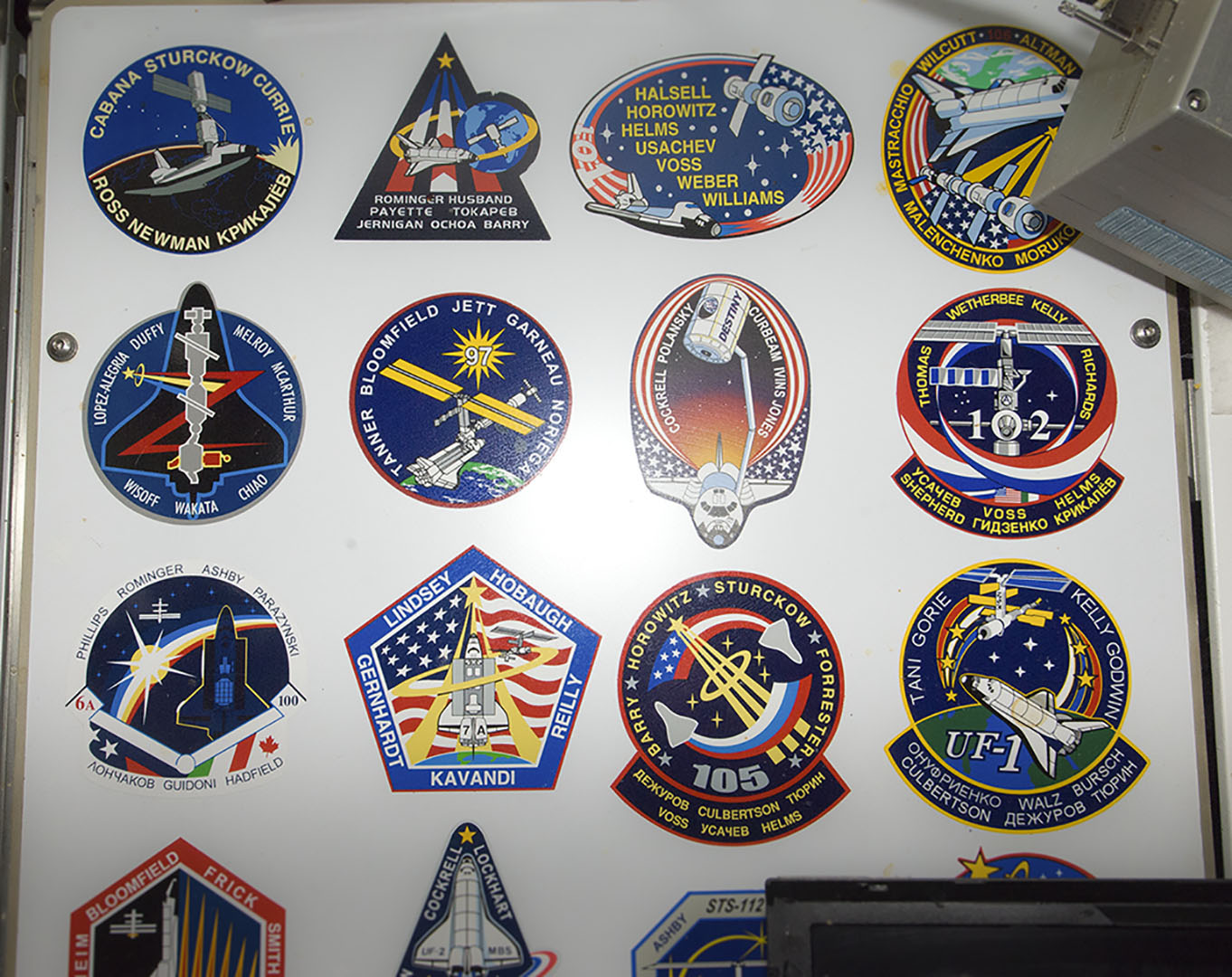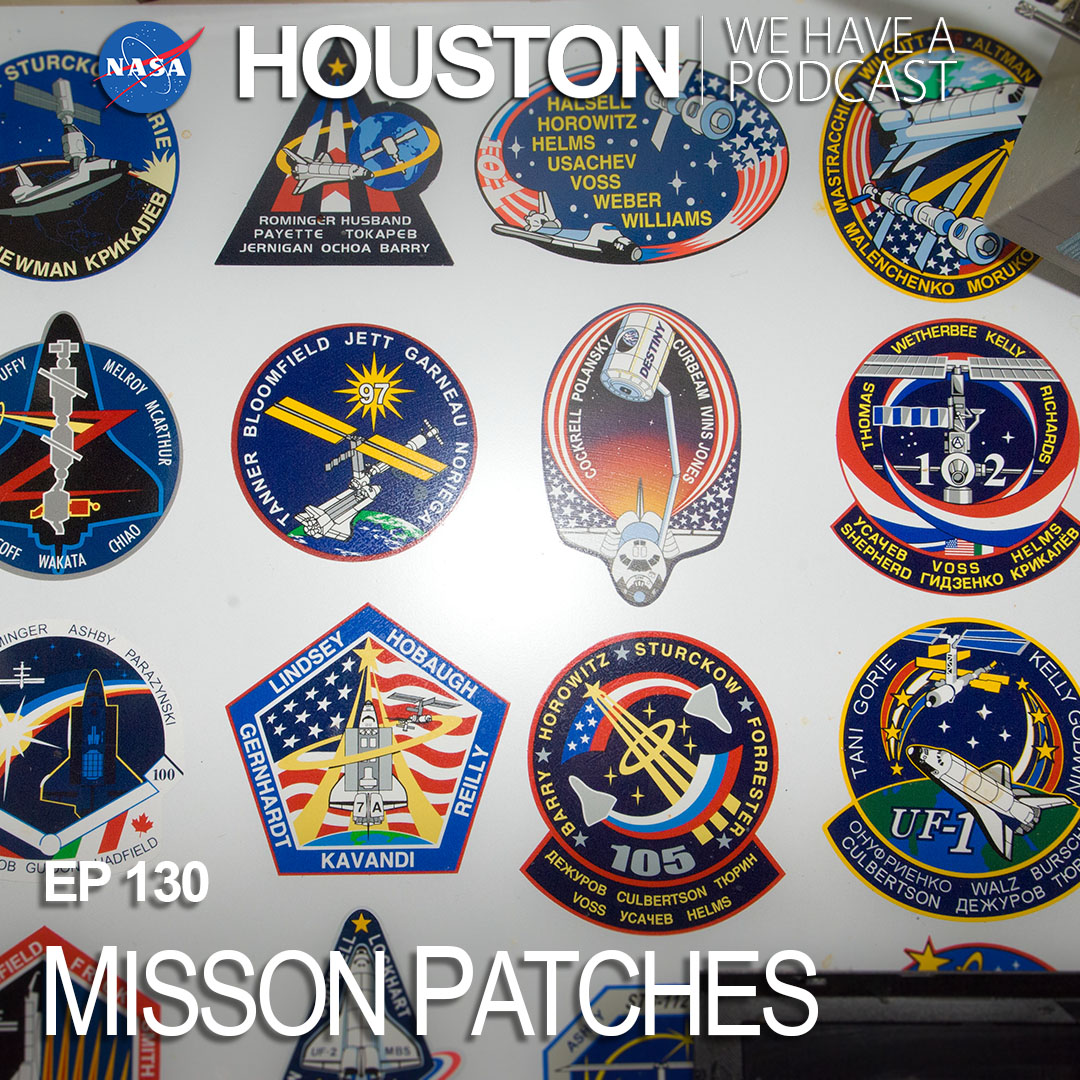
If you’re fascinated by the idea of humans traveling through space and curious about how that all works, you’ve come to the right place.
“Houston We Have a Podcast” is the official podcast of the NASA Johnson Space Center from Houston, Texas, home for NASA’s astronauts and Mission Control Center. Listen to the brightest minds of America’s space agency – astronauts, engineers, scientists and program leaders – discuss exciting topics in engineering, science and technology, sharing their personal stories and expertise on every aspect of human spaceflight. Learn more about how the work being done will help send humans forward to the Moon and on to Mars in the Artemis program.
For Episode 130, Sean Collins, lead graphic designer at Johnson Space Center, discusses the history, design and symbolism that goes into creating the iconic NASA mission patches. This episode was recorded on January 7th, 2020.

Transcript
Gary Jordan (Host): Houston, We Have a Podcast. Welcome to the official podcast of the NASA Johnson Space Center, Episode 130, “Mission Patches.” I’m Gary Jordan, and I’ll be your host today. On this podcast, we bring in the experts, scientists, engineers, astronauts, all to let you know what’s going on in the world of human spaceflight. You don’t have to know a lot about human spaceflight to know that there are a lot of patches. In fact, you see it a lot as a fashion icon nowadays. Many recognize the famous Apollo 11 patch. Most around the world recognizes our logo, or what we call the meatball around NASA, the blue circle with the red vector. But, for those that work at NASA, these mission patches can signify a lot more. It can be a symbol that represents a team, an idea, or a reminder of values embedded in NASA culture. And, this has been rooted within the culture since NASA’s beginning. Coming on the podcast today to tell us about the significance, the history, and the design of these mission patches is Sean Collins. He’s a lead graphic designer here at NASA, and he’s been designing these patches for nearly 30 years now. So, here we go. Everything that goes into the iconic NASA mission patches with Sean Collins. Enjoy.
[ Music ]
Host: Sean Collins. Thank you so much for coming on the podcast today.
Sean Collins: Thank you for having me.
Host: This is a very interesting topic. It strays a little bit from what we talk about. We’re very technical when it comes to engineering and science, and we talk a lot about spaceflight. This is very much a part of the culture, but this is a different topic because we’re dealing with patches which sounds, I guess, I’m saying it’s different, but really, it’s so much a part of NASA culture and history. I’m really excited to talk to you about it. You’ve been doing this for quite some time.
Sean Collins: Yeah.
Host: How long?
Sean Collins: My whole career.
Host: Oh, wow. Alright, so.
Sean Collins: About 34 years.
Host: So, tell me about your background. How’d you get up to the point where you came to NASA and started doing this?
Sean Collins: I went to Southwest Texas which is now Texas State.
Host: OK.
Sean Collins: For just a semester and a half, and then I found a school down here in Houston, Tex Academy Art, an 18-month course. The first place I applied was OmniPlan which had just taken over from Kentron. And, I got the job, and been here, and every five years, we change contracts. So, I work only for NASA, but it’s a NASA contractor. Every five years, minority owned contracting.
Host: Got it. So, when you first came here, what was going on in the world of human spaceflight? What were some of the first missions that they put you on?
Sean Collins: Russ Byther was working on STS-8 when I started.
Host: Alright. Early shuttle.
Sean Collins: Yeah.
Host: OK. So, you, I guess, started. You weren’t designing patches right off the bat, but you eventually got to that point where you were thinking about, where you were assigned to design the patches for some of these early shuttle flights.
Sean Collins: Oh, yeah. I just started off as an associate.
Host: OK.
Sean Collins: I worked my way up into the design department and started doing patches, full airbrush patches, you know, about 30 inches around. And, space station paintings even back then. We did enough to stack them up to the station.
Host: [laughter] Alright. Well, let’s set some background here. So, for our listeners, what we’re talking about patches, it’s, you know, let’s start there. What’s a patch?
Sean Collins: Yeah. Crew patch is just the, you know, to determine the mission and it has an icon to go to when people, you know, see the patch. They go, oh, that was 51-L, that was STS-7, whatever. As, sometimes has their names on it. Most of the time has all the crew name on it, but there’s been a few that they haven’t put names on.
Host: Yeah. So, one of the ones that I think people think of a lot when they first think of NASA, they’re probably going to think of that blue logo with the red vector that says NASA right across it. So, what’s that one?
Sean Collins: The NASA meatball, we call it. It’s the NASA insignia. It’s a federally protected logo, and it’s got all kind of rules on the PMS colors, the pantone matching system. It’s 286 blue, 185 red, and white. You know, so.
Host: Been working with that one for a long time, I’m guessing.
Sean Collins: Yeah.
Host: So, what’s the significance of that federally protected logo?
Sean Collins: Well, it’s the branding of NASA, so, you know, people weren’t using it. But, we see it a lot of times. People take it and make it into other things.
Host: Yeah.
Sean Collins: But, it’s not supposed to be. We have to follow the rules when we’re doing the logos for the astronauts.
Host: So, what are the rules?
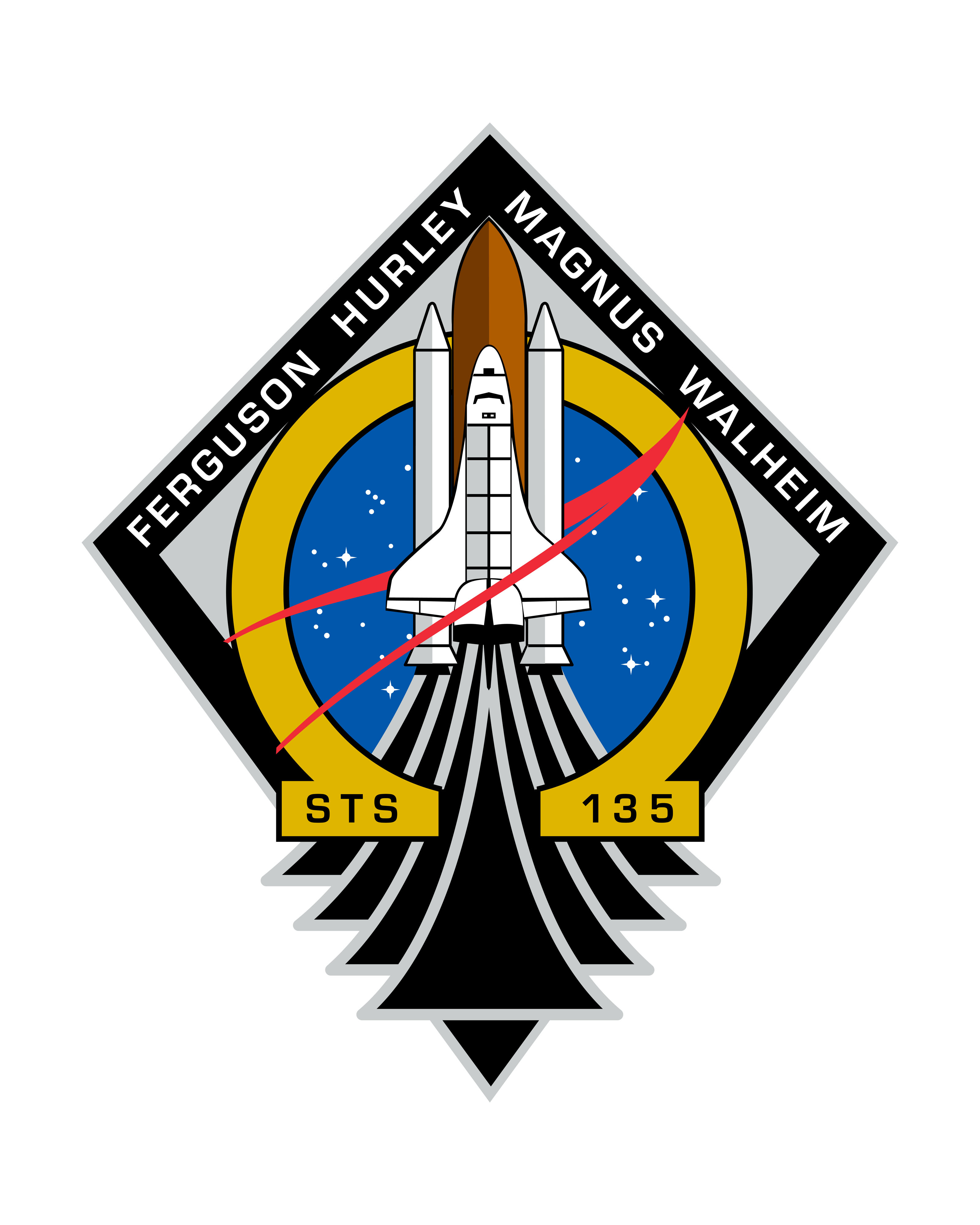
Sean Collins: Don’t use any parts of the NASA meatball unless it’s approved by headquarters.
Host: Because you design some of the patches for the missions that are going to space station to shuttle, so you can’t take that vector, you can’t take that orbit, you can’t take those letters and play with them in the logos.
Sean Collins: Yeah.
Host: OK.
Sean Collins: Unless it’s got approval for like return to flight missions they’ve put it on, and they’ve put it on, I believe the last one had it, too. Yeah, the last 135 had it on it. It got approved because that was the last shuttle mission.
Host: Significant milestones like that. That makes sense. So, it’s a very powerful logo when it comes to NASA, something that we think of as iconic. I know another one, this, and I say this is on t-shirts. But, really, that blue one, the meatball that you’re saying, the meatball is on t-shirts, hats, everything you can imagine. Everyone’s putting that. It’s even a fashion statement now which is pretty funny. But, there’s another one called the worm, and it was a red almost a snake-like logo of the outline that spelled out NASA.
Sean Collins: Yeah. That was retired in ’92 when I was here. I remember them retiring it and bringing back the NASA meatball. The NASA meatball, I think, was done at around ’59, airbrushed, and then I redrew it. Headquarters redrew it, and then I redrew it again in Illustrator.
Host: Oh, OK.
Sean Collins: Actually, it was Canvas Deneba was pre-programmed before Illustrator.
Host: Yeah– I’m actually very curious to explore some of the technology and how that’s progressed over time. I know the worm was a, it was a rebrand initiative, really, when it came to NASA, right? When it first came around. Where, when you first started, were you working on the meatball and then transition to the worm, or were you already?
Sean Collins: Nah. It was on the worm.
Host: It was on the worm already. OK.
Sean Collins: In ’83. It was easier to use on print products because you could balance, you know. The NASA meatball has the vector sticking out. It never really can center it right. You got to off center it to get it centered. It’s really an eye centering thing.
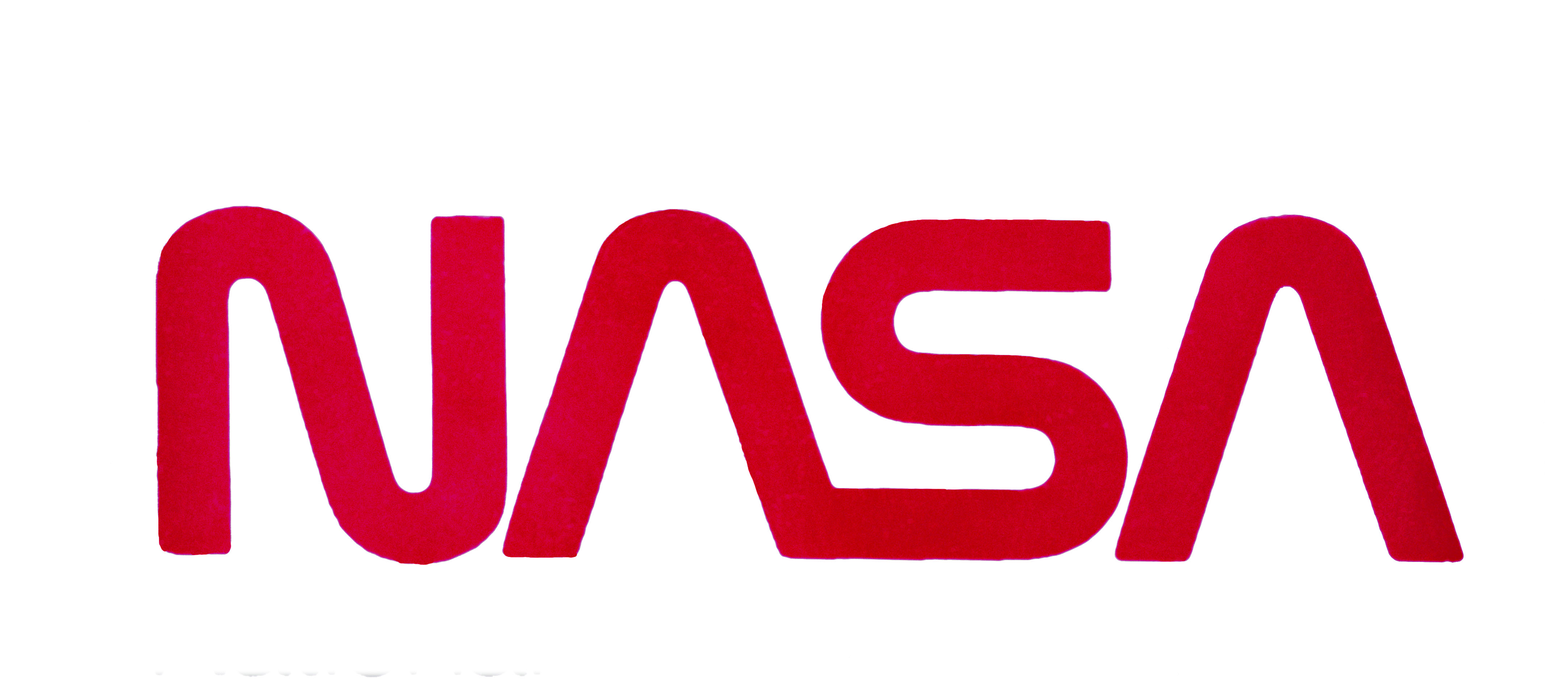
Host: Yeah.
Sean Collins: And, of course, you can do one color in the worm, black, white, or grey. Actually, four I guess, grey and then the red. So, and it was, I guess, cheaper to produce printing. So.
Host: So, a rebrand, and for a graphic designer, it was a lot more flexibility on your end.
Sean Collins: Yeah.
Host: Because you said there’s a lot of rules when it comes to framing and branding, and I know one of the popular things that I see is it is a NASA stylebook.
Sean Collins: Yes.
Host: That tells you exactly how to use the meatball and where to position it. And, it is, from what I’ve seen, very precise.
Sean Collins: Yeah. Very precise. It even tells you where, how bit the type is, National Aeronautics next to it has to be and where it lines up with the bottom of the NASA and where it goes in the corner of the page and what other logos can go with it. And, they have to be smaller.
Host: So, what’s some of the surprising, I guess, restrictions or rules or guidelines that people might not know when they’re looking at a NASA product?
Sean Collins: When designing a poster, you have an area at the top that’s supposed to be only, you can’t have anything any part of your poster in that, or, you know, the background has to be black or white behind the meatball. Where if it’s full color, you have to use a black and white. So, it kind of restricts you when you have your poster goes all the way to the top, and then, you check it out. And, they say, “No, that’s in the NASA meatball area.” So.
Host: Yeah, you got to have this almost blank space, it sounds like.
Sean Collins: Yeah.
Host: OK.
Sean Collins: Usually just fade it into the dark space.
Host: OK.
Sean Collins: Or white, so.
Host: So, that’s how you know, really, that it’s an official NASA product is when you’re following these guidelines because it seems like not everyone seems to follow those guidelines. So, maybe they’re not the more, they’re just slapping the meatball wherever they want.
Sean Collins: Or, they’ll use a 3D meatball from like the internet. You’re not supposed to do that for any print products. You’ll see it, and they don’t hold the shift button when they size it, and you’ll get an egg, or you get a squished meatball.
Host: Yeah, a lot of restrictions. It’s almost like, I mean, it is a branding exercise. So, when you’re working with that you have to follow these restrictions and stay within these guidelines because that is the brand.
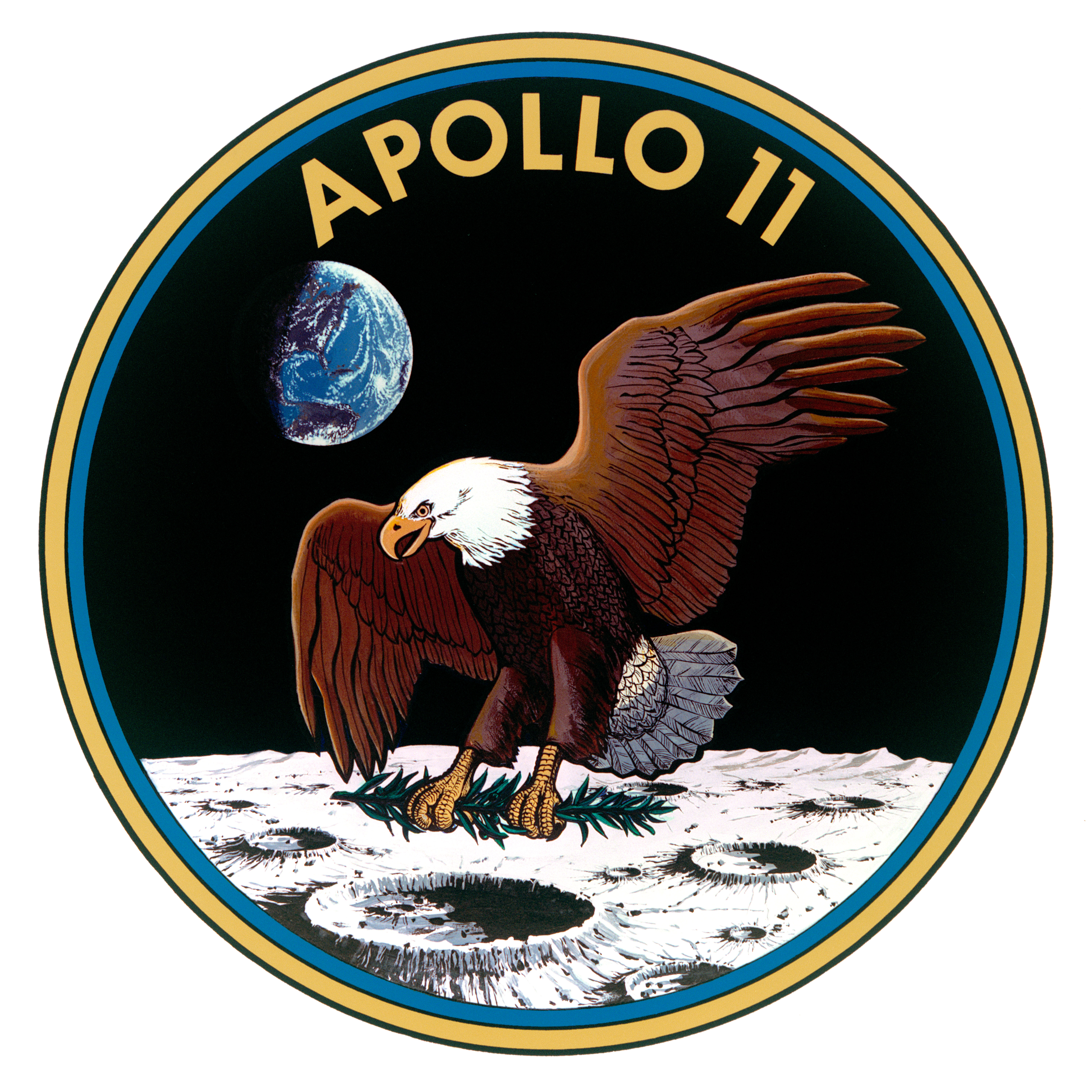
Sean Collins: Yeah.
Host: That’s what you have to do. So, let’s talk about some of the other ones besides the meatball, besides the NASA brands themselves. I’m thinking about iconic patches. So, if people are thinking about patches other than just these logos that we see that are the identifier of NASA, the one, the first one at least, that comes to my mind is the Apollo 11 patch. This is the one I think, I’ve seen it a bunch of times, and there’s a very iconic parts to it. There’s an eagle that front and center. You have the Moon right behind that, and then one of the key elements there is there are no names on this patch because this one was famously for all mankind.
Sean Collins: Yeah. And, you know, it has olive leaves bringing peace to the Moon, I guess. And, yeah, and, because everybody at NASA was behind that mission, so they couldn’t just put three people. It’s kind of, my dad’s name is Michael A. Collins, and he worked in Mission Control back then, during Apollo 11, so.
Host: Different Michael Collins.
Sean Collins: Different Michael. He’s the Michael Collins. [Laughter]
Sean Collins: So, that was kind of a neat connection with that patch and that mission. But, of course, that was before my time. I was just a kid watching on TV.
Host: Did you learn, were some of those folks that designed some of those patches around when you started?
Sean Collins: Norm Tiller was friends with a guy I work with, Russ Byther, and he did the 13, Apollo 13.
Host: Thirteen, that’s another one that didn’t have any names on it. What were some key elements of that one?
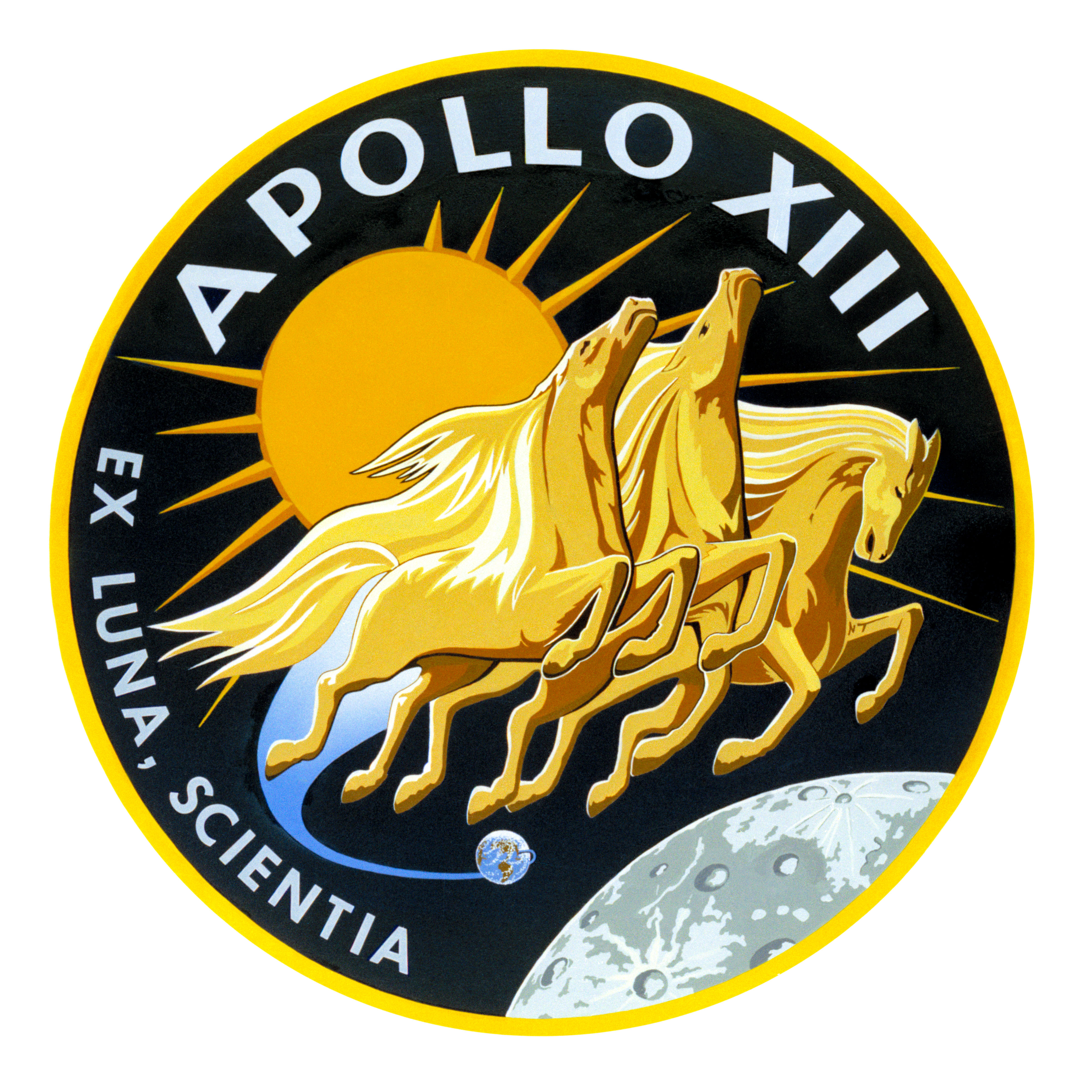
Sean Collins: The three horses, and Norman Tiller put his initials in one of the elbows of the horse, NT, so.
Host: I’m going to have to go find that, now. That’s wonderful. That’s 13, Apollo 13. That was the one that didn’t make it to the surface of the Moon, wrapped around, and it was one of those iconic missions to return the astronauts safely to Earth. So, definitely an iconic patch that everyone really thinks about when they think about NASA patches. Tell me about the first patch that you worked on and what that was like.
Sean Collins: Well, another iconic one was, of course, 51-L, and any time I tell people I had designed crew patches, it like, oh, did you do 51-L, yeah. But, I did the return to flight.
Host: 51-L is the Challenger accident.
Sean Collins: Challenger accident, yeah. And, that’s the interesting thing that we had all men in the design department. That was the first patch designed by a female, a woman, Jennifer Hees. Of course, she worked.
Host: 51-L was?
Sean Collins: Yes. She worked with a crew, you know, put the apple on it. And, but we had a Matro. Back then, we used to airbrush the patches 30 inches. you know, hand drawn everything.
Host: Wow.
Sean Collins: It matched the PMS colors in the paints to pantone matching system. And, had this machine called a Matro machine, and we could burn the text in a circle. So, we didn’t, no longer had to write hand cut, draw the letters out in a circle perspective into the middle of the patch. And so, we could do it all on one sheet, and then just rub them down. So, I did the rub down letters on that for Jennifer, I remember. So, that was probably one of the first patches we started doing that on. Maybe one before that. I’m not, you know, it was a long time ago, but.
Host: And, you don’t happen to know the name of the mission or the, what, was this for 51-L that you were doing the rub down?
Sean Collins: Yeah. Yeah.
Host: OK.
Sean Collins: And, in fact, when we moved our building from 227, in our file cabinet, I found the original artwork of the 51-L.
Host: Wow.
Sean Collins: So, we still have it over there in building eight. So, it’s kind of neat that a lot of the other ones either were given to the crew or given to the History Office. And, this’ll probably go to the History Office or the Smithsonian or the 51-L museum, you know.
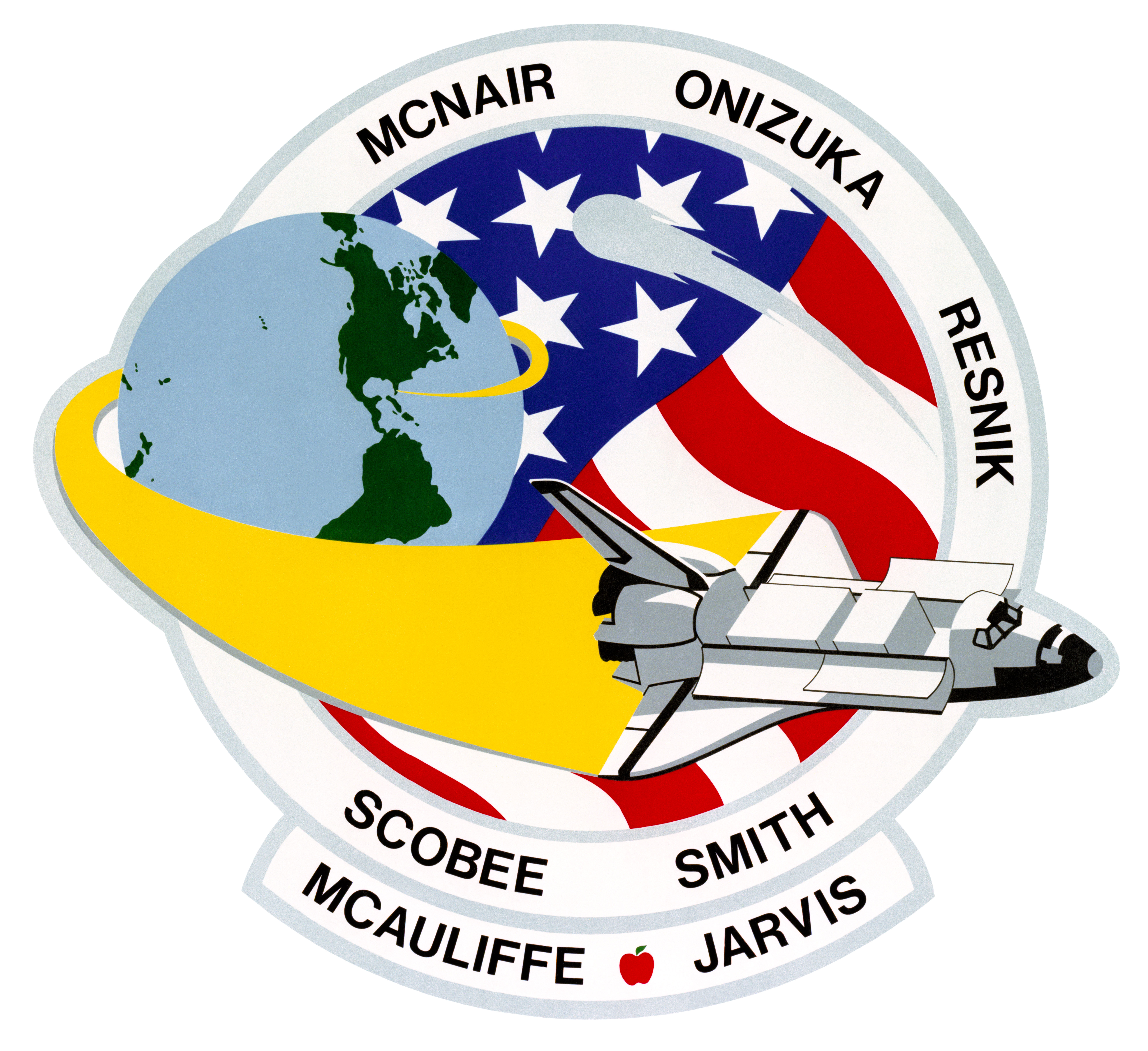
Host: Wow.
Sean Collins: Where Ochoa has.
Host: That’s right. Yeah. Challenger.
Sean Collins: Yeah.
Host: Challenger Center maybe.
Sean Collins: Yeah. Onizuka. I’m sorry.
Host: Oh, yeah. So, this process that you’re talking about, you know, I grew up more of a digital age, so this is a little bit before me. So, what was the process of actually working with this large, you said 30 inch — and you had to airbrush it and everything. What was it like getting from that point to start it to put it onto different products?
Sean Collins: Well, the process you go through with the crew. Back in those days, we’d have five or six crew members giving you input, and I kind of changed that process later down the field. There could be only one, like Highlander.
Host: Oh, yeah.
Sean Collins: You know, Bob says make it green. Bill says make it blue for this. So, I said all the changes come through one astronaut. That’s your coordinator. And, we still had, you know, back then, we still had mainly the commander would be the lead on it.
Host: OK.
Sean Collins: But, you’d still get inputs from all of them, and then. But, once we’d narrowed it down, it had to be nailed down before we went to the airbrush board because the hours put into it. And, I mean, some of these patches would take 200 to 300 hours.
Host: Wow.
Sean Collins: Of work, you know. And then, they change a crew, that’s–
Host: Throw it out and start over.
Sean Collins: Now, they change the crew, we can, you know, it’s on the computer. [Boop sound]. Put the new name in if it fits. You know, unless it’s one of those double names. And then, we kind of got to move stuff around. But, yeah, one of the first patches done was I did in a program called Zenographics. I believe it was there it is. STS-28. So, that was in the ’90s when we started getting computers. And, this was a real low level, you know, your phone is way better than this computer.
Host: Oh, wow.
Sean Collins: And, you could only get 66 points, then you would run out. Then, you would have to link 66 points to connect, you know, the wing of an eagle or a stripe. You know, so you can have, you know, unlimited points where you can [beeping] all you wanted on a computer. It’d run out after I think it was 66. So–
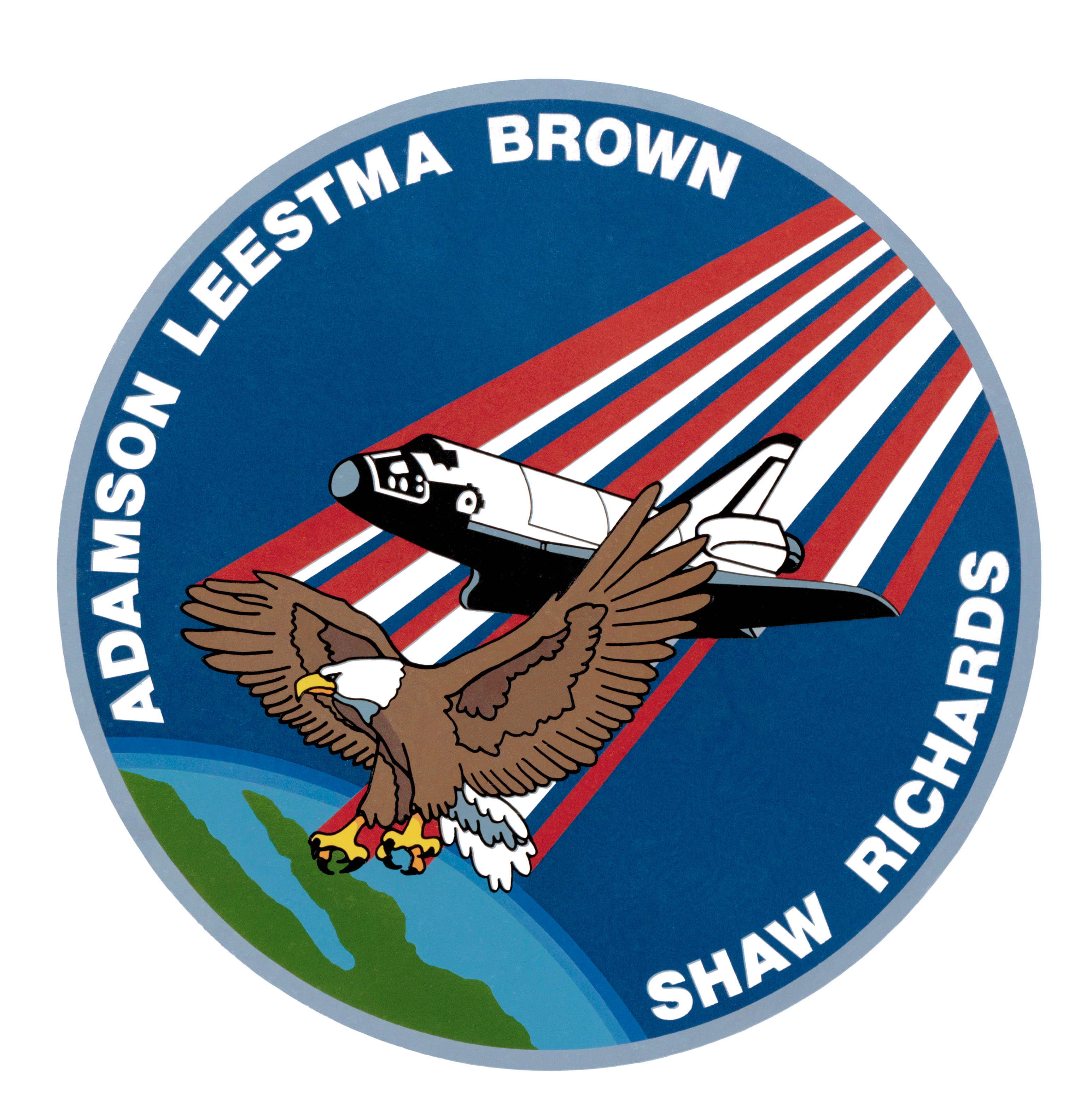
Host: Wow.
Sean Collins: So, you’d have to patch in little pieces of it.
Host: You have to section, make, do it by sections.
Sean Collins: Yeah.
Host: OK.
Sean Collins: Just the wing would take, you know, four or five sections.
Host: Wow.
Sean Collins: Then, we went to, we hit freehand for a while. It was, these, all the new graphics programs were just coming out. And, Illustrator was out, but Illustrator, you would have to draw it and then wait for it to render. You know, [beeping], and then, you’re like, I don’t like that color. So, you’d have to change it on the other. So, we went to a program called Canvas Deneba, and I thought it was going to take off. But, then, illustrator became worldwide, and that’s what we use on all the patches now. It’s like mandatory.
Host: Adobe Illustrator.
Sean Collins: Adobe Illustrator.
Host: OK. So, yeah, that technology has progressed, and it sounds like the time dedication has definitely shrunk from.
Sean Collins: Oh, yeah.
Host: From the time you were doing it with airbrush to the time of these archaic computers to now.
Sean Collins: Yeah.
Host: Yeah, sounds like it’s definitely some work. And, I don’t know if this is a good thing or a bad thing, but now you can deal with changes as they come down.
Sean Collins: Oh, yeah.
Host: A little bit easier.
Sean Collins: Expedition 57, yeah, got changed a lot of times.
Host: Yeah.
Sean Collins: The names on it. And, 58 back and forth, you know, back all the names. We did a lot of conversions on that.
Host: I guess an important point to mention here is these patches, they’re not just something that you come up with and you’re like, “This is what’s going to identify your crew now.” This is something that you’re working very closely with the crew members of that mission.
Sean Collins: Yeah.
Host: So, tell me what that’s like from the time they start working with you?
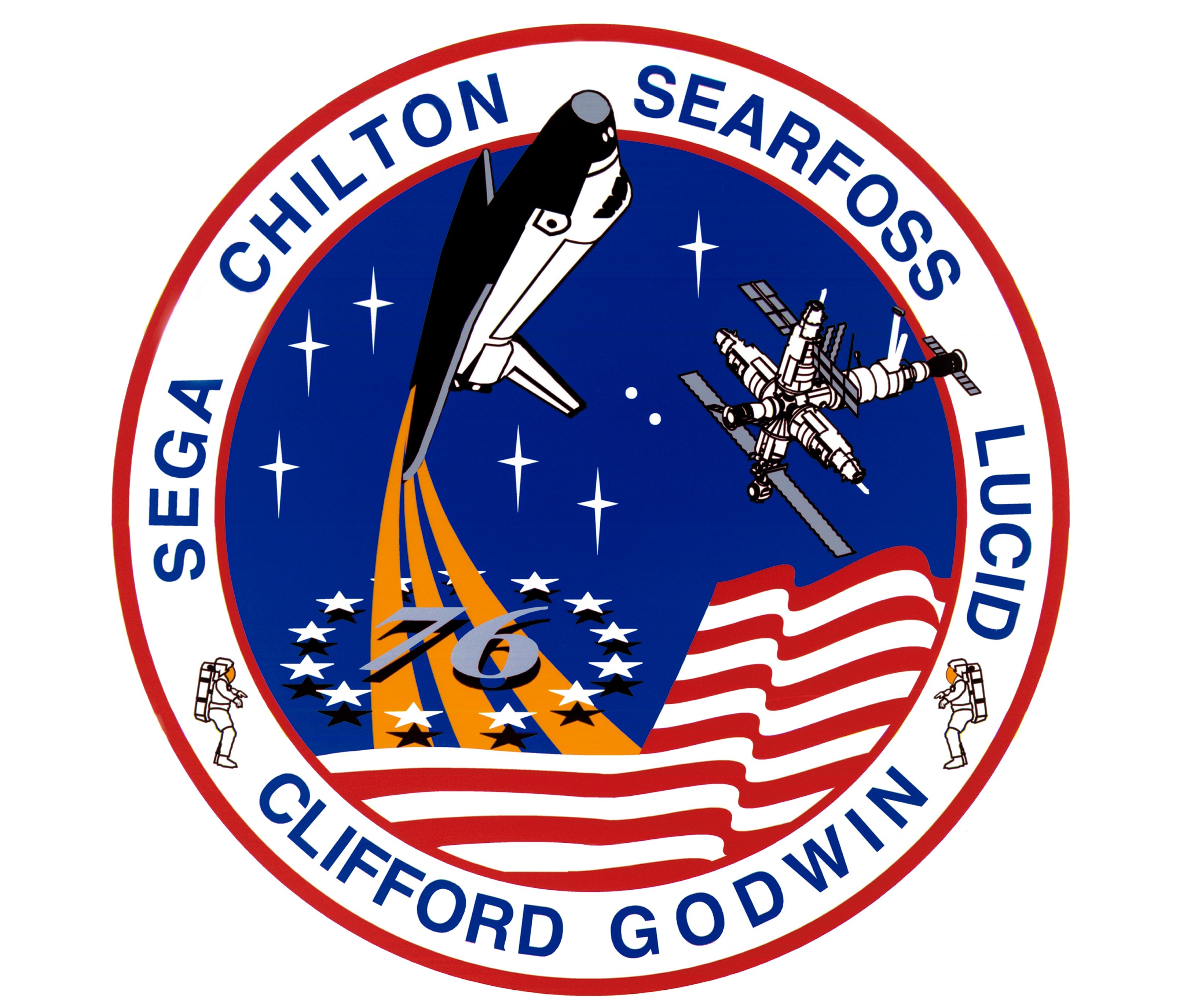
Sean Collins: Well, sometimes, they’ll come to me and say, you know, “come up with an idea.” And, I come up with it, and then, you know, the crew interacts with you. Sometimes, it’s from an outside designer. It could be an uncle, a friend, or acquaintance of the astronauts. It could be a family member. STS-76, I had, was it Rich Clifford’s nine-year-old son had drawn it in colored pencil. He came into my office. I had a nine-year-old art director. That was kind of cool, and now that kid’s grown up, and he’s an architect.
Host: Alright!
Sean Collins: So, that was an interesting story on that. We’ve had, I mean, everyone, it’s a team effort. I mean, they’ll show people in their office. They’ll show their neighbors. They’ll show their family, and they’ll come up with new ideas and we interact it and see what works. Sometimes, it doesn’t work, and we, you know, toss it. Sometimes, the crew patch can have 20 iterations, you know, 20 different patches until we nail one down. And then, we start to tweak that one once we get a real good design down. Some I’ve done in four hours, you know. So, the simple ones, but we’ve done other patches that have gone all the way to print and get the AB Emblem does all the sewing since the beginning. I think they were even doing Apollo patches.
Host: Wow.
Sean Collins: So, we work real good with them. They don’t really make any money off of it because, they make, except for, “Hey, we do the NASA patches,” you know?
Host: Yeah.
Sean Collins: That’s why, and they work real well with us. And, but, the decals will go out to, you know, three bids, to Spaceflight Awareness pays for those now, and the decals will be sent out, they could be printed in Illinois or California, Texas, Chicago, wherever. It just, whichever bid they pick.
Host: Yeah. Those folks are through our office.
Sean Collins: Yeah.
Host: I believe the Spaceflight Awareness folks.
Sean Collins: Yeah.
Host: It’s a lot of work. Are there guidelines or frameworks when it comes to when you’re starting to work on a patch? It has to be these dimensions. It has to be this shape. Are there any restrictions there?
Sean Collins: It has to be around four inches.
Host: OK.
Sean Collins: You know, if they’re irregular shaped, you know, it could be maybe 4 and three-fourths tall, but then it can’t be, you know, 4 and three-fourth’s wide.
Host: Yeah.
Sean Collins: But, most of them. I mean, they’re round or oval-ish shape. Some have some, you know, some of the expeditions got one. They’re shaped like a galaxy. And then, that was the outside designer. We do get outside designers who don’t follow the, we have an eight color PMS rule, pantone matching system, because that’s all you can print in pantone. Even though that’s changing with all the digital printing. So, that might be changing pretty soon. We’ll be full color photographic patches, the way the printing has progressed, you know. But, you have an eight-armed octopus that prints like t-shirts, you know, that the print. You ever seen a t-shirt printer? It’s got the arms [swooshing sound]. That’s kind of the basics for doing decals, too. It’s screen printing.
Host: I see.
Sean Collins: But, with all digital printing, you know, you can print right on a board now, on a canvas. And so, that’ll probably change, but they like to still keep it in eight colors, so it doesn’t get all. A lot of the outside designers were too in a paint program, you’ve got 380 colors, and we have to redraw it, get it down to eight colors, and make it look, you know, block colors. They did a gradient on STS-68, and that cost a lot of money to print it back then, and they said no more gradients. [Laughter] So, gradient was where you, you know, have a light color goes into a dark color.
Host: Right.
Sean Collins: And, it’s hard to stitch that. It’s hard to print it. It’s just costs like four times as much.
Host: Is that the only gradient?
Sean Collins: I believe it was. Oh, we’ve got tons of outside designs that are.
Host: Sure.
Sean Collins: Come in with gradients and we–
Host: Say no. [Laughter]
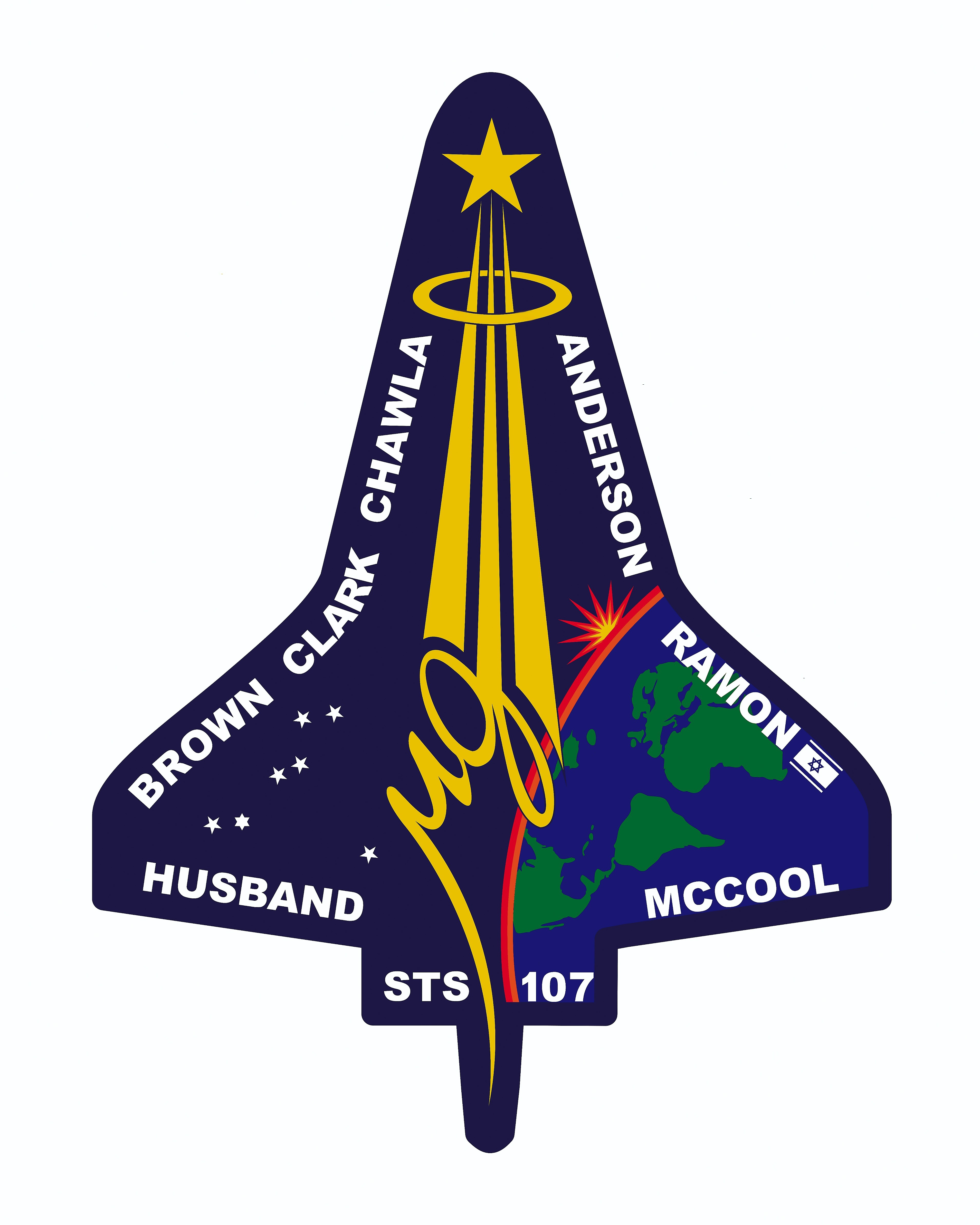
Sean Collins: We fix it. We redraw them, so. The other ones, you know, there’s some that are kind of. Oh, return to flight 114. That was already done and printed, and then, the accident happened. See, we work on these patches sometimes two years in advance, especially in the earlier missions because the airbrushing and everything.
Host: Right.
Sean Collins: But, after 107, I’m sorry. The accident, they decided to put the outline on the top. Worked with Steve Robinson, and we had just a kind of a vector size ship, just a little arrow tip, you know, non-descript. So, we took the shuttle outline that was used on 107 to commemorate them and put it onto the 114 patch.
Host: And, this is another one of those iconic patches. This is the patch of the Columbia mission, of the Columbia accident. Return to flight is the one after that. They took the outline of that Columbia mission and put it on the top. I see it now. That is wonderful.
Sean Collins: Yeah, and a lot of the patches, if you look at them, they’ll have the seven stars, like the Orion configuration. That’s usually for the seven.
Host: That were on Columbia.
Sean Collins: And, we’ve done, you know, seven on one and three on another. We, a lot of things, and if you read the back of the patch on the decal, it’ll give you, you know, explanation of the patch. So, that’s kind of interesting how things go into it like that. There’s a lot of hidden stuff on patches that astronauts have me put in their kid’s initials, their, you know, like we were talking about earlier the joke names for the different [Astronaut Candidates] ASCANs that, the astronaut training class, the maggots, the hairballs.
Host: Right.
Sean Collins: There’s one in there with a hairball in the helmet. It’s a little cat. There’s a pig in there for I guess they were called the hogs.
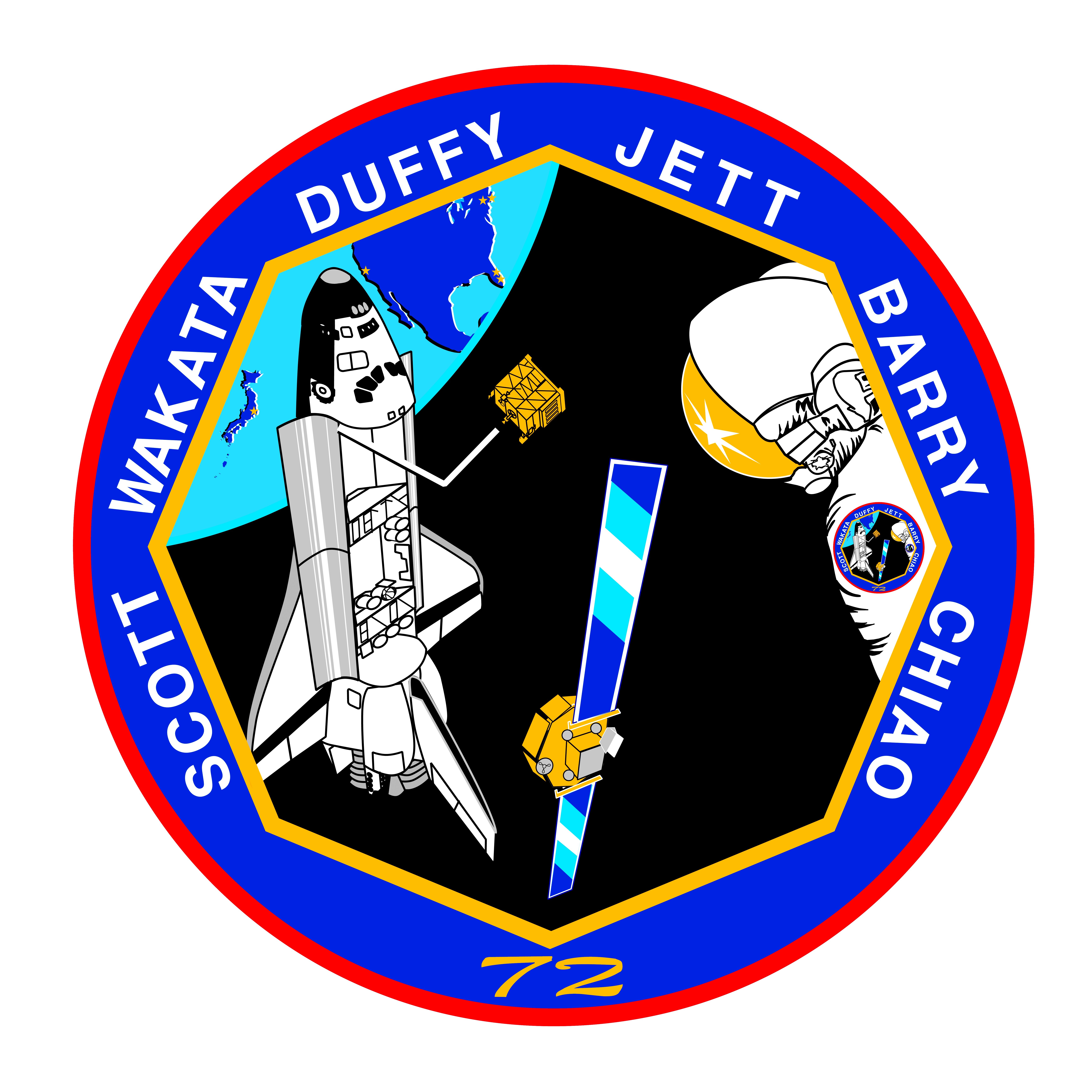
Host: Oh.
Sean Collins: There’s one with a chicken bone in it. For, I guess they were called the chicken bones. But, STS-72 probably has the most initials of all the kids. It’s got basketballs, chicken bones, hairballs. It’s a patch within a patch within a patch within a patch.
Host: Oh, wow.
Sean Collins: And, it was a fun patch to work on.
Host: You got to work on that one?
Sean Collins: Oh, yeah. A lot. And so, the patch, there’s an astronaut in the patch, and he as the actual 72 on his patch. If you zoom in on the computer, there’s another patch on that guy. You zoom in. I think we took it into six zoom ins where it wouldn’t, you know, you couldn’t tell what it was anymore. But, there’s six patches inside that one patch.
Host: That is crazy.
Sean Collins: If you look at STS-40, it’s got the Di Vinci guy, [Vitruvian] Man, I believe. And, the muscles across his stomach say “Sean” in it. [Laughter]
Sean Collins: I got invited to that launch. Worked on that Gutierrez–
Host: So, these are very, these are very personal. These are very meaningful to the crews that are helping design. Because how involved there that you say you have one rep. You say you have one crew member. Everything has to be filtered through them, otherwise it gets crazy and you get pulled in different directions. But, they’re, it sounds like they’re injecting all of these different elements. Is it as they think of them? Is it all in like one batch and they say, “Here you go,”? How does that work?
Sean Collins: Well, they, we started to doing it. I kind of changed that when I became lead. There can be only one, but they still, I’ve had my whole office full of the whole crew in there, everybody in there. But, you know, you still have the coordinator, and it’s usually the commander. And, you get to be good friends with them, too. You know, all these astronauts, you, we hang out, go camping, go to renaissance, and really nice guys and gals. It’s been fun over the years. Met a lot of friends that still, you know, they’re not flying anymore, but we still hang out. So.
Host: Oh, wow. I didn’t realize it was that close of a relationship.
Sean Collins: Oh, yeah.
Host: Yeah, because I guess this is taking some time. You say sometimes some of the early patches were 200 hours’ worth of work, but then how much of that is the back and forth communication with the astronauts and working with them? Is it over months? Is it over?
Sean Collins: Oh, yeah. With the early patches, yeah, because we did them so far in advance.
Host: Yeah.
Sean Collins: And, yeah, and you do a lot, and you’ll send it. Like, working on the Crew One SpaceX patch right now. It was an outside designer, but I’ve changed the border. I’ve changed the words. I’ve added stuff from the [Mission Operations Directorate]MOD logo. And then, we took that off. And so, it was already done, but it was drawn in a weird program. So, I had to redraw it in Illustrator and fix it, and it just got sent off for approval today. And, just that going back and forth was only like eight hours. You know, but they had worked with the designer before they came to me.
Host: OK.
Sean Collins: But, I don’t know. It’s funny that you have a job of people like it so much they do it for free. [Laughter] So, the astronauts will get bombarded with designs before we’d even get a work order started. So.
Host: Really?
Sean Collins: So, that’s, and then that’s why a lot of the times we’re going, oh, it’s another outside designer.
Host: And, you have to be the one to go in and start tweaking everything so it.
Sean Collins: To make it where you can print it, yeah.
Host: To make it where you can print it. So, I know there’s, you know, when you’re talking about the designing, different patches and what goes into a NASA patch, you talked about things that are very personal within the patches, something that, you know, the initials of their kids’ names, elements that describe what astronaut class they came from. I know there’s elements within patches that have special and significant meaning, whether it comes to spaceflight or other things. I think one of them are the three stripes that lead up. I believe that’s something that signifies maybe human spaceflight. Is that right?
Sean Collins: With the, it’s the astronaut logo has three stripes with the orbit and the star at the top.
Host: OK.
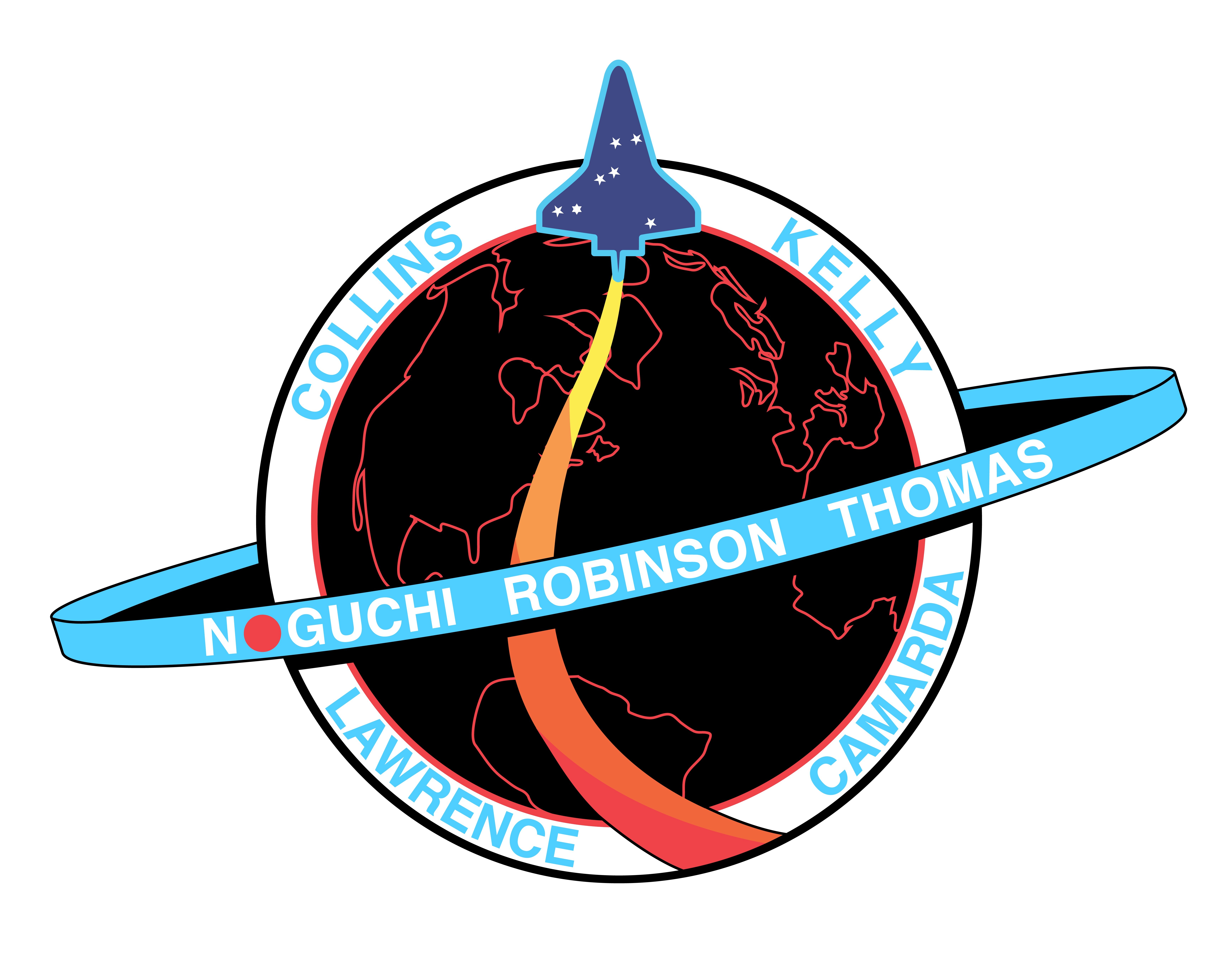
Sean Collins: So, yeah, that’s been incorporated in a few of them, and then, you know, it’s been bent and twisted, like, here’s one there. And, here, yeah. 123 was the, that’s Rick Linnehan’s flight. He’s a good friend of mine. I’ve been, done three of his patches, three of his four. And, I’ve got invited to launches, and we worked on it awhile, and it actually did, I forgot the name of the robot on that patch but had him fighting Godzilla because they went to Japan. And so, they can make t-shirts out of that, too. So, it’s fun stuff. There’s some that, like, incorporate double patches that have meaning from they were on another mission. So, they’ll have a little basic outline of the patch that’s kind of incorporated. Sort of like 114, you know, has the outline of the shuttle on it. Lot of stars. Lot of eagles. You know, and some will have, you know, if they had a payload, a special payload in the shuttle or on special payload on station patches, it’ll be highlighted on the patch. You know, this part was brought up.
Host: Yeah.
Sean Collins: You know, the station.
Host: So, something significant to the particular mission that they were. And, these missions are, it seems like, you know, it’s a mission. This is a shuttle mission and something, you know, a shuttle going up and down doing some task, whether it’s a space station assembly or maybe Hubble. Have you worked with some of the expeditions as well?
Sean Collins: Oh, yeah, lots.
Host: Yeah, space station expeditions.
Sean Collins: I’ve done a lot of those patches, too. And, it’s the same thing. You’ll have, like, you’ll have a station, or you have a highlighted part of the station that’s being, you know, gym module or whatever module was brought up. They will highlight that part. And then, some are just, I like the simpler, yeah, I say less is more. And so, the simple ones like 46 kind of looks like a NASCAR patch. Just 46 and the names and the little flags over the Earth. I had an original 46 on there. It was like a stylized in perspective 46. Got patches made, and then somebody said they didn’t like it because it looked like another symbol. So, I just did a regular 46. It was like, you know, four and the six combined. And, then it looked like a NASCAR, but it was kind of cool because Mark Kelly had it, and you know, he’s gone up so many times. He looks like a NASCAR driver with all the patches. So.
Host: That’s right. 46. That was Scott Kelly’s one-year mission, right? That was.
Sean Collins: Now, there was a special patch done for that.
Host: Oh, OK OK. Well, yeah. He was – what was he? He went from 46 through 49.
Sean Collins: Five missions probably.
Host: Yeah, I forgot what the numbers were. Man, I should know. I should be able to pull this out, but. Yeah, I’m sure they all blend together after doing it for so long, right?
Sean Collins: Yeah. Yeah, and like, a lot of the patches now for station, they’re on three different patches, you know. 57, 58, 59.
Host: Yeah.
Sean Collins: You’ll see the same names, and you know, they went up with the 57. They’re coming down with 59, but then, when they’re on 59, 60’s part of their crew, too.
Host: Yeah.
Sean Collins: So, that’s why I can’t wait until we start launching from here one crew, one mission. [Laughter]
Host: Yeah, yeah, yeah.
Sean Collins: And, that’ll be a lot easier on the patches, I think.
Host: That’s actually a good question because with commercial crew coming up, they’re, for example, SpaceX is going to be launching on a SpaceX Dragon, Crew Dragon, bringing for the, especially for some of the first flights NASA astronauts. I would maybe some international ones. Will you take part in designing some of those patches?
Sean Collins: Yeah, I’m working on one right now, two actually.
Host: Really?
Sean Collins: And, about a year ago, I tried to corner this because I saw it coming. You know, who’s doing these patches? Are we doing patches or is SpaceX doing the patches, or are we doing the patches?
Host: It’s a good question.
Sean Collins: It’s still up in the air, but I’m still, like the Crew One for SpaceX, it’s a dragon head in a circle. That’s the one I’m working on that was done by an outside designer. But, it was through SpaceX sort of, but now we’re fixing it to go to print. But, it’s kind of, you know, when, if they would follow the same rules we did. You know, the type has to be at least a quarter inch, three-eighth inch so you can sew it. Anything smaller turns into a little knot, you know.
Host: Oh, yeah.
Sean Collins: So, and we got to fix that a lot. But, it’s still my favorite part of my job. I do other things like posters and signs and drawings and everything to do with graphics, but this is my favorite part of the job, doing the logos.
Host: Yeah, the patches. That’s really exciting. So, I guess, you know, NASA astronauts are going, are launching from Florida, so naturally, you know, you being able to work so closely with the crew that are going to be launching and designing elements of that. Whether it’s a SpaceX or Boeing or whatever, just making something personal for them is pretty meaningful. Yeah. So, tell me about some of the more recent patches that you’ve worked on using Illustrator and what that’s like for, you know, working more digital patches and some of the more recent crews. You talked about expeditions when they’re going on long duration stays on the station. They’re sometimes going across multiple missions, so having their input in multiple different patches and things like that.
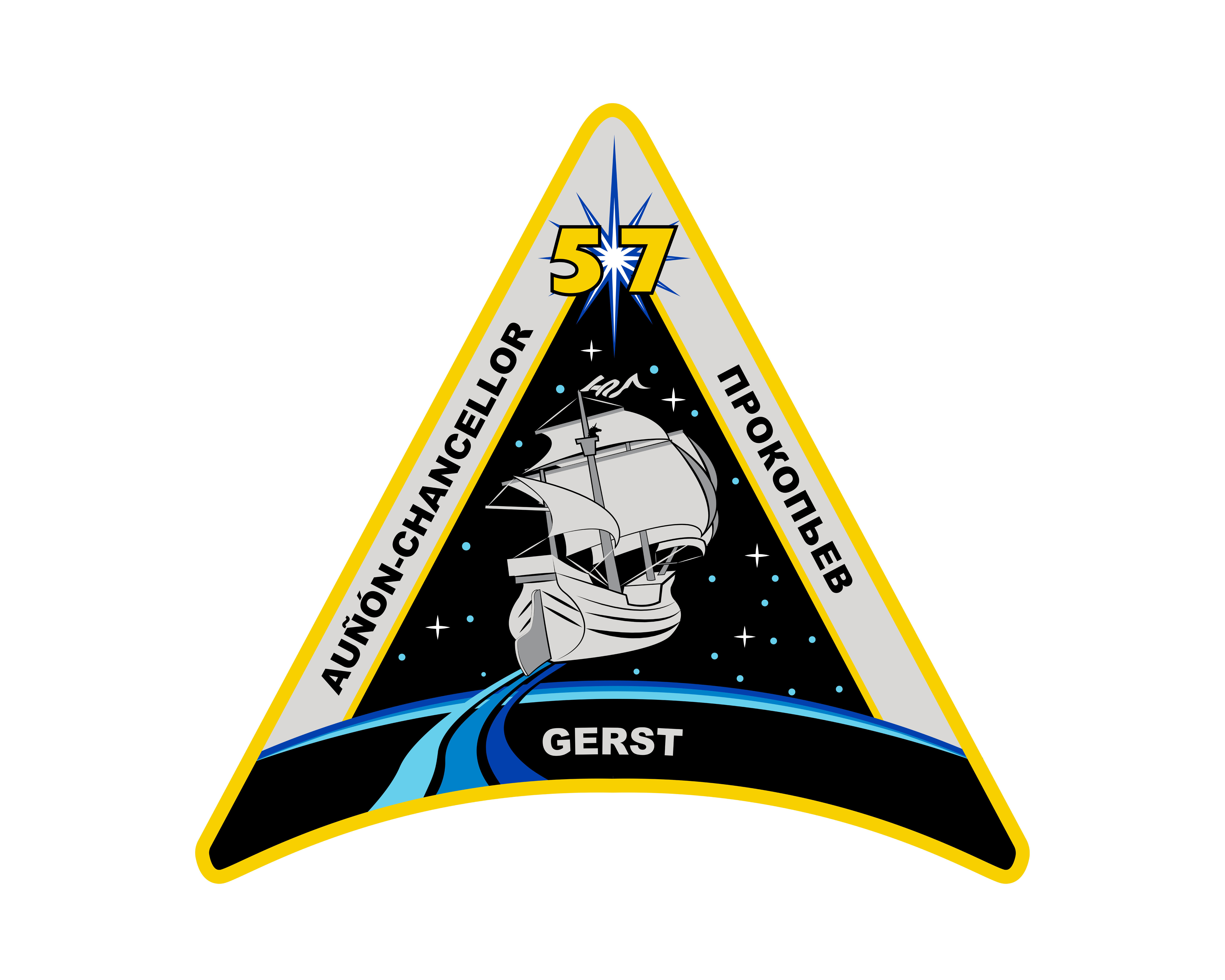
Sean Collins: Yeah. Like Expedition 57. Did a ship on it over the horizon. Did the ship coming at me, then did the ship going away, ship sideways, and we ended up with the ship going away. But, the names were changed. That crew changed a lot, and then we, it had a wave behind the ship, and so, some of the names are too long. So, I had to move that wave. I moved that wave back and forth a few times.
Host: Yeah.
Sean Collins: To make it, you know, curve back in to fix it. So, in Illustrator, it’s still kind of complicated to get concentric wave lines, like a zoom going into it. You know, if you move it over to the right, then it doesn’t look anymore. So, you have to move the other part of the curve. Then, you get it just right, and then, they add a different name, and then you got to do it again. So.
Host: Wow.
Sean Collins: But, it was real fun working with Alexander Gerst on it. Good guy, and I got to be good friends with him, too, so.
Host: Man, I’m so jealous of how closely you get to work with them and do something so personal for the crew. It’s something that they wear constantly up there, and they’re proud to show because it’s their mission and they wear it on them whenever they’re going around to different events. They’re in their flight suit with the mission that resembles which one they were on.
Sean Collins: Yeah, and then after their flight, I design their montages.
Host: Oh.
Sean Collins: I basically do 95 percent of those. Basically, all of them now.
Host: And, what are the–
Sean Collins: When they come down, it’s like about the eight best photos they had from the mission. In 16 by 20, and there’s room for a flag or a patch. Now that they’re going up on Soyuz, they don’t have enough room for flags. Like, the shuttle, you know, they could bring, you know, 1000 flags, 1000 patches or more, and shuttle they, you know, pound and a half in their leg pocket. So, getting one of those back, and these go to kings, queens, popes. They’re going to the Hill this Monday bringing them to Senators and Congressmen. And, that’s for the 59 crew. I’m finishing that today. But, a flown patch or a flown flag will go on, and usually the patch is embedded, you know, photographically into the photoshop montage. So, if they don’t have a flown one, then they still have their emblem. And, of course, they’ll have it, you know, on their uniforms in the photos, too. And so, those are coveted items. When you get presented one of those, you know, with a flown item on it, people love those. And, I love them, too. I get a lot of them. So, after working on a patch for something with the astronauts, you’ll get awarded one afterwards. So, it’s a little piece of history.
Host: Yeah.
Sean Collins: That flew in space, you know. It’s always fun.
Host: That is cool. I know, you’re right. They do give them around as little emblems. I know even, yeah, these little things, and you were talking about montage. So, I guess, correct me if I’m wrong, you put the patch on top of the picture, this flown patch. And, the picture is of these best images, and you’re able to frame that and keep this memento.
Sean Collins: Yes.
Host: Yeah.
Sean Collins: And, it has a little flown statement. You know, this flew on STS-123, you know and the date. Might have a little inscription about what happened in that mission.
Host: Yeah.
Sean Collins: So.
Host: So, tell me about some of the ways that these patches are used. You’ve talked about the patches are printed and flown. You’ve, we’ve talked about them having to be so, you know, even the print, the words having to be so large so that you can actually sew them, and they act appear. Decals. What are the products whenever you create a design and you approve it. Actually, that’s another good question is how do you approve it? But, where does it go, and what other sorts of things are they incorporated in, and what are the restrictions on how they can and cannot be used?
Sean Collins: Yeah, the, another good product that comes out is the lapel pins. Those are, they make those, and they, those get done by Winco I believe, and so they go out and they have thousands of these made. And, those are kind of collector’s items. They, you know, print on coffee mugs, hats, t-shirts, even the badge holders, you know, the straps they put on. They put them on little flags, I’ve seen them. I guess that’s about all.
Host: Yeah.
Sean Collins: But, making, you know, mainly the patch. That is Astronaut Office, the sewn, embroidered patch, and then, of course, we have a digital file that the astronauts will use on their presentations for, you know, PowerPoint. They’ll put it in there when they’re giving a speech when they go to a school or something. It’ll be up on the screen. Seen a lot of hats, too.
Host: [laughter] Yeah, I got a beanie from one mission when I was going out to support for Public Affairs. So, I covet that one for sure.
Sean Collins: Koozies, too.
Host: Koozies, yeah, that’s a good one.
Sean Collins: From what’s that, Expedition 51. Got some koozies made for Peggy Whitson.
Host: Very cool.
Sean Collins: Another good friend.
Host: Alright. I’m starting, I’m more and more jealous every time you name drop there. But, what about the approval process? I did elude to that. So, whenever you’re designing something, you’re getting all this input from an astronaut, when you can say it’s ready to go out the door.
Sean Collins: Well, the coordinator will, of course, approve it. Then, it goes to the Astronaut Office. Then, it goes through their management.
Host: OK.
Sean Collins: And, I believe it goes through headquarters to, like, the astronaut posters we do. Those go through, like, 12 approvals. But, once it gets approved, then we add the thread colors and the PMS color blocks and a little die cut bleed mark on the illustrator file. And, it’ll go off to a bidding for the decals. Now, the AB Emblem has the contract, and they’ve had it forever for the sewn patches.
Host: I see.
Sean Collins: So, they’ll go up and make those.
Host: So, now, with some of the more recent missions, using Adobe Illustrator, going the more digital route, what’s about the time that you would start working on a patch to the time where it’s ready? What’s the, what’s the–
Sean Collins: It just depends on the crew, how many iterations they want to make. I mean, it could be done in four hours, and it could be 40 hours. We do have a limit of 45 hours from the Astronaut Office because of funding, so.
Host: OK.
Sean Collins: When we get close to that, we let them know, and then they’re like, oh, wrap it up. [Laughter]
Sean Collins: But, and sometimes, they’re allowed to go over. Like, when a crew changes or something, some of the missions, one I worked on was Expedition 52 became Expedition 54, but they wanted their patch. So, it was a stylized 52 up in space. So, then, I turned it into a stylized 54 up in space. So.
Host: OK.
Sean Collins: So, they got, you know, because they worked on their patch. They were happy with it. They wanted, but their whole crew got changed out with the other mission.
Host: Yeah.
Sean Collins: So, there were going to be Expedition 52. Now, they’re 54, but they want to take their patch with them. So, we, I just made it into a 54. Same shape, and so, they didn’t have to change much except the 54 in it and a couple of the names, too, the crew members.
Host: Very cool.
Sean Collins: Changed out.
Host: Do you know the number of patches and missions that you’ve worked on in your career? Do you have a number?
Sean Collins: That’s hard.
Host: I figured.
Sean Collins: Because, you know, I worked on that one, that one, that one, that one. Designed that one, but did you really design it because you worked with a whole crew with it, you know.
Host: Sure.
Sean Collins: There’s a couple that I did all the way from scratch, you know. I’d say they’re in the, you know, ten in that, but there’s probably 200 that I’ve done, I’ve worked on.
Host: Wow.
Sean Collins: From, and plus, I did do all the [Name of the Russian Space Station] MIR patches.
Host: Really?
Sean Collins: MIR missions, there’s, you know how many? Twelve. I mean.
Host: Yeah.
Sean Collins: But, I just designed the original one, and we changed.
Host: All the ones with NASA astronauts.
Sean Collins: Yeah, I changed the names out. So, they had one patch for every mission.
Host: OK.
Sean Collins: So, that was for their MIR missions.
Host: I see.
Sean Collins: So, you know, do those. Plus, we’ve done side logos. You know, we used to do the ASCAN. We did do the ASCAN crew photo, crew official patch. Now, their joke patch for, they always get nicknamed one from the crew before.
Host: I see.
Sean Collins: See, that’s where the hairballs or the maggots or whatever.
Host: Oh, but you make it as a fun thing for the crew office to–
Sean Collins: Yeah, we used to, but they don’t fund that anymore. So, they have to go outside and get an uncle or aunt or cousin to do those.
Host: That’s funny. OK. I didn’t even realize that classes had patches to identify the class.
Sean Collins: Yeah.
Host: That’s interesting.
Sean Collins: Well, they have an official one.
Host: Yeah.
Sean Collins: At NASA. There is one, and I put the, do their crew photos, too. I don’t take the photos. It’s taken by the NASA photographers. Then, I cut them out in photoshop and put another background, but always put their patch in.
Host: OK.
Sean Collins: In the photo, either ASCAN crew or shuttle crew or station crew or, you know, now commercial crews.
Host: Alright. So, it’s like the number class, like class, I don’t know.
Sean Collins: Yeah, 13 or yeah.
Host: Thirteen or whatever it is. OK.
Sean Collins: Yeah.
Host: Wow.
Sean Collins: So, they all get, you know, their crew photo. The crew patch gets used in other products, not just the patches and decals. So, it’s placed into their poster. We do a poster for every mission, and it’s funded through [Spaceflight Awareness] SFA, and they will have the crew patch in it somewhere either as a, you know, part of the design or on them or in front of them or sometimes standing on the floor and they’re standing on it and photoshop. So, it’s used, you know, artistically, too. You know, not just here’s your one little sticker or decal.
Host: Yeah.
Sean Collins: It’s put in different things.
Host: In different things. What are some of the projects that, you know, reflecting on now, are more meaningful or are a highlight of your career?
Sean Collins: Those SFA posters for each crew.
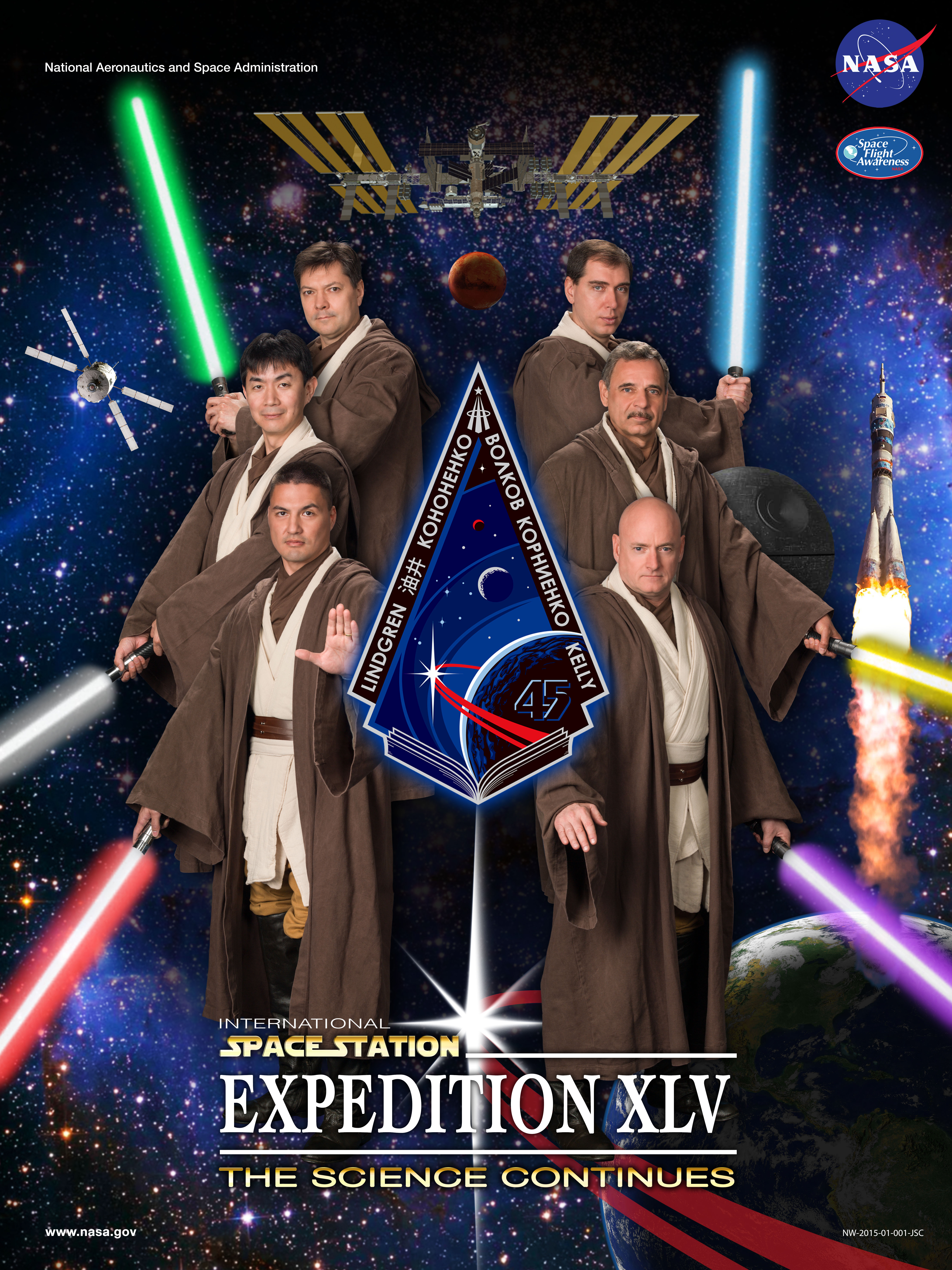
Host: The posters are a highlight.
Sean Collins: With the crew. Yeah, when we got to do the parody posters. Those were a big.
Host: Oh, yeah.
Sean Collins: You had a “Star Wars” one, ” The Matrix.” What’s some other ones? “Guide to the Galaxy,” “Oceans 12” we did. And, those were a lot of fun, and they had the crew and had the crew patch in it, too. But, so they were fun. But, now, they’re getting more serious, and we don’t do those anymore.
Host: Oh, OK.
Sean Collins: But, they were real popular. That was one of the funnest things I’ve done, working with the crews and doing that, posing them and going over, so.
Host: That sounds awesome. I know some of them, I can see them in my head because I’ve seen them around so many times. I find them really cool. I know there’s one that was based kind of off of the graphics of “Firefly.” There was one, I know “The Matrix” one. There was one that was “Pirates of the Caribbean.”
Sean Collins: Yeah.
Host: That one looked pretty – you did that one, too? That one looked fun.
Sean Collins: Yeah.
Host: Because they were in costumes. Yeah.
Sean Collins: Yeah, those were my costumes. [Laughter]
Host: Were they really? This is the pirate costume. Wonderful. How about patches that are more meaningful? Something that you think has a little bit more deeper meaning in your career.
Sean Collins: Well, of course, you know, 51-L and 107.
Host: Yeah.
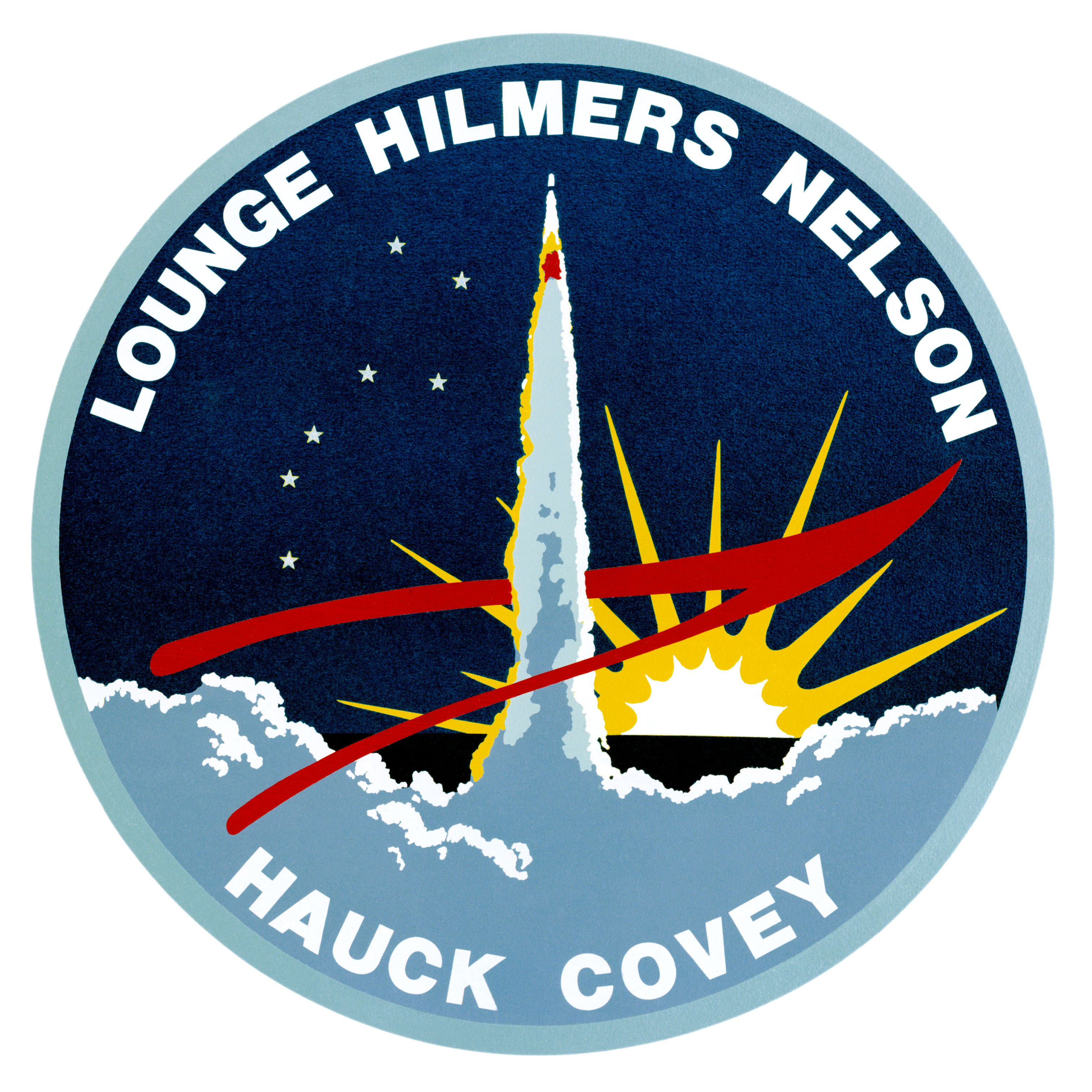
Sean Collins: They’re, I didn’t work on except for doing the lettering on 51-L, but. And, the return to flights and my first one, I guess, the STS-26 and the return to flight 114. But, a lot of them, you know, ones where, like, all of Rick’s patches are meaningful because I got invited to the launches by Rick and went and saw them, you know. When you know somebody that’s going up on the shuttle that’s a good friend, you know, it’s a different feeling. You’re like, oh, hope everything’s alright, you know.
Host: Yeah.
Sean Collins: So.
Host: This is Rick.
Sean Collins: Linnehan.
Host: Linnehan. OK.
Sean Collins: Great guy. Those are, all Rick’s patches. LeRoy Chow, good friend, too. Those are meaningful patches to me.
Host: Some of the ones that are significant in spaceflight history but also ones with really close almost friends.
Sean Collins: Yeah.
Host: Yeah.
Sean Collins: Oh, they are friends.
Host: Yeah.
Sean Collins: And, you know some of them are kind of funny. The one that looks like the bikini.
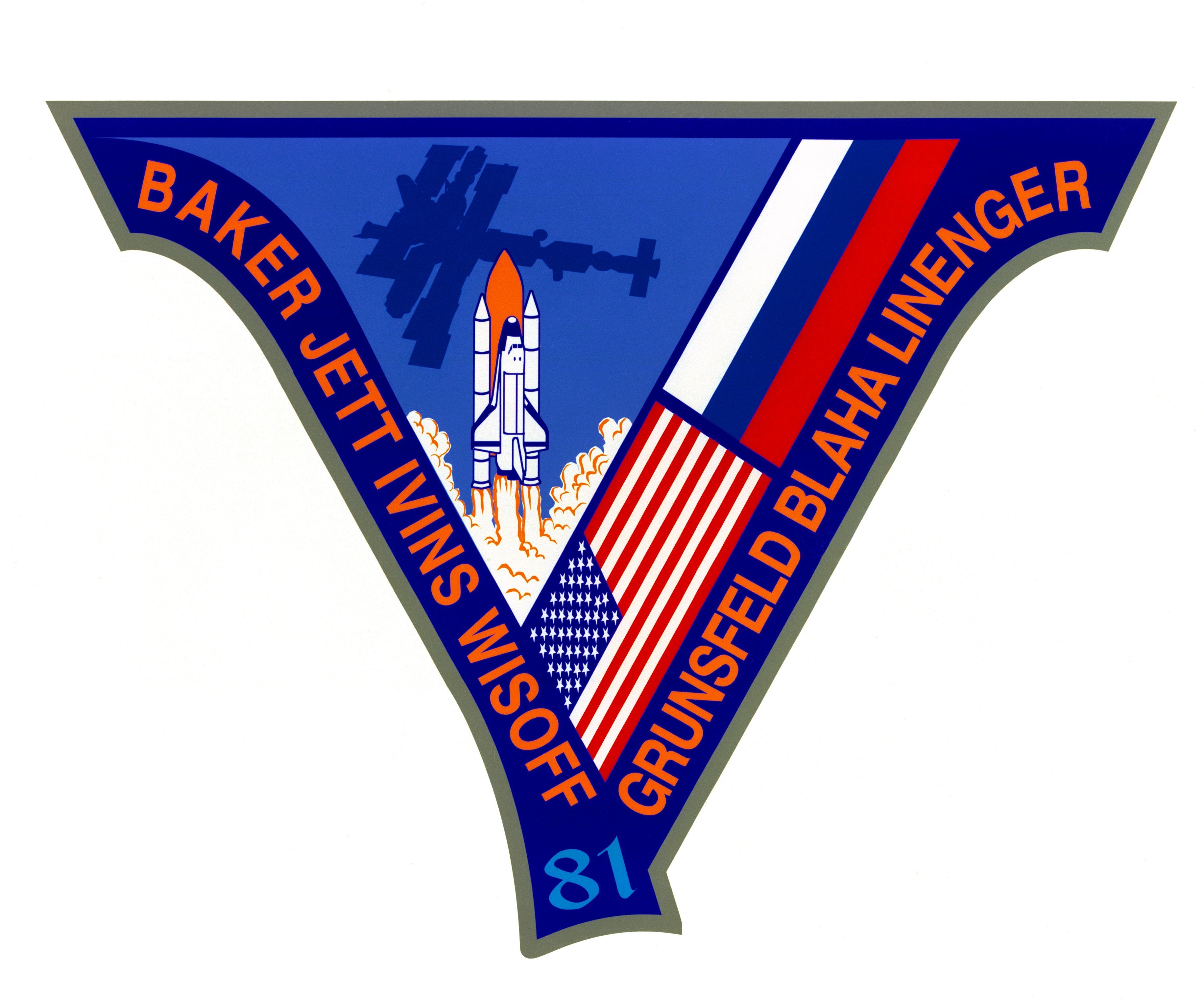
Host: Oh, that’s funny.
Sean Collins: Yeah, and the flat tire one.
Host: Flat tire.
Sean Collins: That’s what I call it. I did that one in ’79. What is that one? I can’t see it. It’s so little, forty-one I guess.
Host: Forty-one.
Sean Collins: Call that the bikini patch because it’s, you know, shaped like a–
Host: It’s got, like, an upside-down triangle.
Sean Collins: Yeah.
Host: That’s funny. That’s, so thinking about, you know, these patches, we’ve gone through a lot of patch ideas and fun designs, and it’s just, it sounds like an absolutely fascinating career. You just sound like you’ve had so much fun with it throughout the years. But, do you think this is something that will stick with human spaceflight for at least the foreseeable future, if not forever? Designing patches and for specific crews and working so closely with them?
Sean Collins: Yeah. I think it does because it’s such a history in it, and everybody, that’s how you identify the mission, you know. You’re like what mission were you on? Oh, you know, they see the patch. But, I’m thinking that they might go to where there’s no names again because they’re, you know, when you’re over three different missions or expeditions, when you’re up there for, you know, a year or two, you’re going to have different people coming. I think it might be, but then, you know, the new astronauts miss out, they won’t have their name on it, you know.
Host: Yeah.
Sean Collins: On the part of history, and that’s how you can go back. It’s history for sure, and so, take a lot of, you know. Make them. Oh, here’s one, too, 133. They were working on a patch design, who was that guy I used to work with, Terry. He doesn’t work there anymore, but he was working on with the crew, and then he gets a, the astronauts got a package from McCall, you know, from McCall did the mural, Bob McCall did the mural in there.
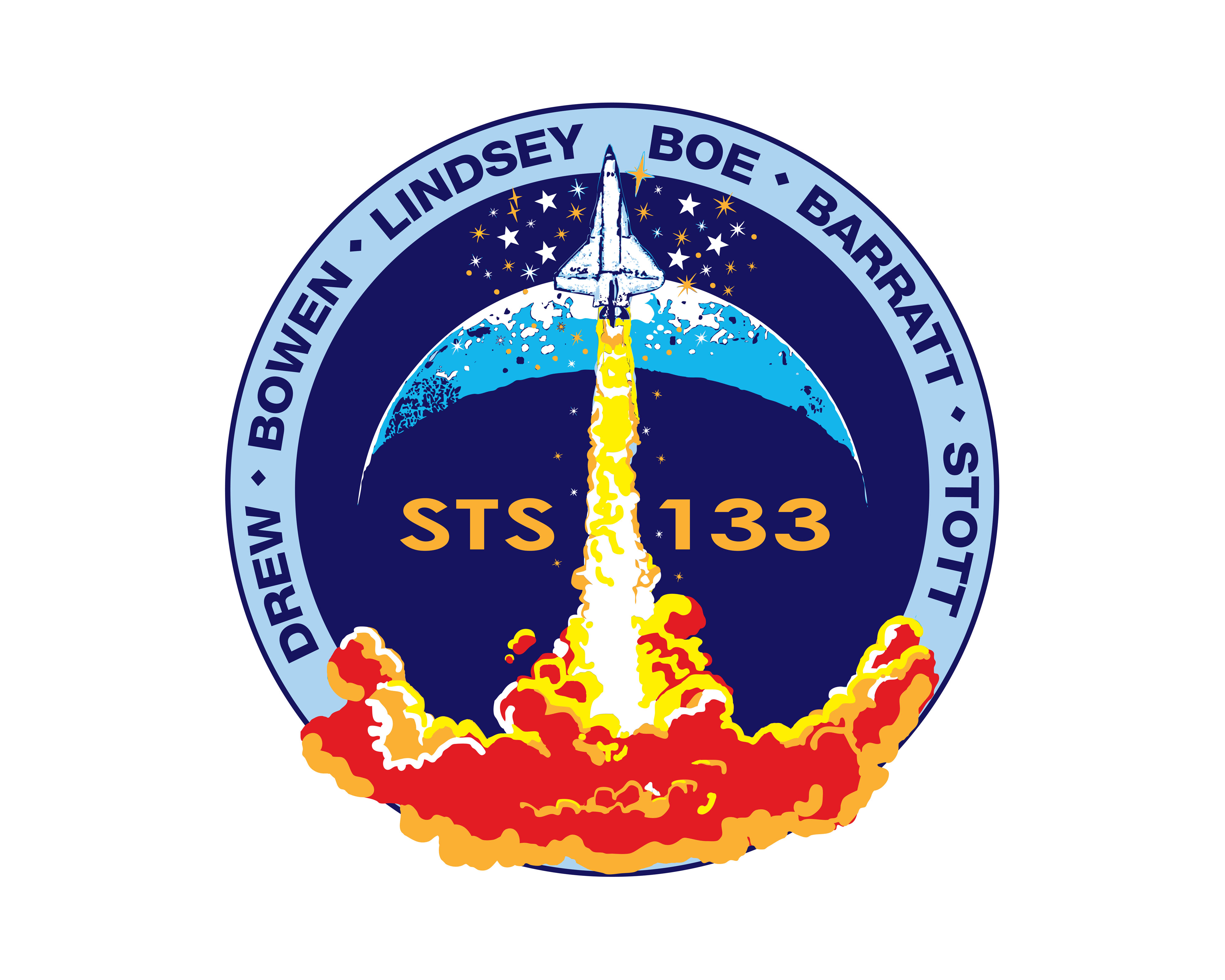
Host: That’s right, yeah. We just celebrated his 100th birthday, I believe. Yeah.
Sean Collins: He, but he had passed, and this package got mailed to them after he died. But, it was already in the mail, and they got it and, oh, we’re doing this. So, Terry redrew the watercolor little sketch just point to point, you know, meticulously so that it matched that watercolor sketch completely. So, that was kind of interesting that he’d already passed but his design made it to the astronauts.
Host: Wow.
Sean Collins: So, that was kind of neat. My last shuttle patch was 132, and so that’s a pretty significant one for me, doing that one. I got basically designed it all the way, and you know, little tweaks from the astronauts.
Host: Yeah.
Sean Collins: That was a fun one, too.
Host: Wow. What a history. Yeah, and Robert McCall, he’s got that mural right in the building next to us, that very famous mural of.
Sean Collins: He hand painted that, too. It was awesome.
Host: Very, very cool. Do you think art has a very significant place in spaceflight and history to commemorate some of these moments and engage people?
Sean Collins: Oh, yeah. That’s the thing, engaging people, too. Art does that. Can be, you know, even through your podcast, engage people. You, the media, the videos, of course all the awesome photography that comes out of space, you know. I just got one today for Expedition 60, and it was a Soyuz coming at the station, and it’s got, like, you know, the squiggle from the launch. You can see that.
Host: Yeah.
Sean Collins: And then, you see, like, the burst around it. I’m like, oh, I’m using that on the montage for 60 when I get that workorder. [Laughter] It’d been good for on a crew patch, too. So.
Host: I like the 60 patch because 60 came around at the 50th anniversary of Apollo 11, so that was one of the few expedition ones that had no names on it.
Sean Collins: Yeah.
Host: Yeah. I know that.
Sean Collins: I didn’t do that one.
Host: Oh, you didn’t do that one?
Sean Collins: I believe that was outside designer, too.
Host: Really?
Sean Collins: Think around who worked on it in my office. See, we work on these so far in advance, like the mission’s going on now that we worked on it a year and a half ago, you know.
Host: Wow.
Sean Collins: So, that’s, I’m, I work on stuff that happens in the future. So.
Host: Well, it’s very exciting to hear about the commercial crew stuff coming up. I can’t wait to see some of those, and it’s been exciting to talk to you about your career and some of these highlights of these patches. I’m going to have to go back and re-listen to this podcast and listen to all the different numbers of the missions that you talked about and all of these different Easter eggs in the mission patches. What a wonderful thing because you’re right. There’s a lot of history, but it sounds like it’s very personal to the crew, and it can tell us a unique story. Sean Collins. Thank you so much for coming on Houston, We Have a Podcast.
Sean Collins: Thank you for having me.
[ Music ]
Host: Hey, thanks for sticking around. Really good conversation we had with Sean Collins about mission patches today. If you liked our conversation, there are plenty of more episodes of Houston, We Have a Podcast at NASA.gov/podcasts. Also, many other podcasts from other NASA centers around the U.S. where you can find some of the talks that they go into such as planetary science or what’s going on the in the world of launches or. We have a couple of them, so go check them out. The Houston, We Have a Podcast, we are on the NASA Johnson Space Center pages of Facebook, Twitter, and Instagram. Use the hashtag #askNASA on your favorite platform to submit an idea. Just be sure to mention it’s for Houston, We Have a Podcast. This episode was recorded on January 7th, 2020. Thanks to Alex Perryman, Pat Ryan, Norah Moran, Belinda Pulido, and Jennifer Hernandez. Thanks again to Sean Collins for taking the time to come on the show. Give us a rating and feedback on whatever platform you’re listening to tell us how we did. We’ll be back next week.






























